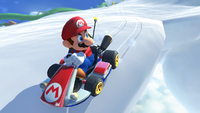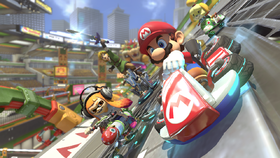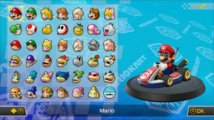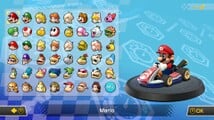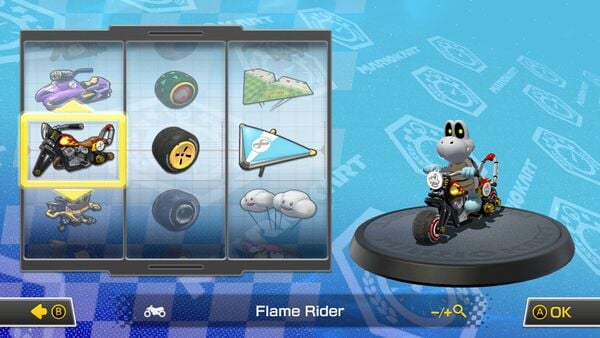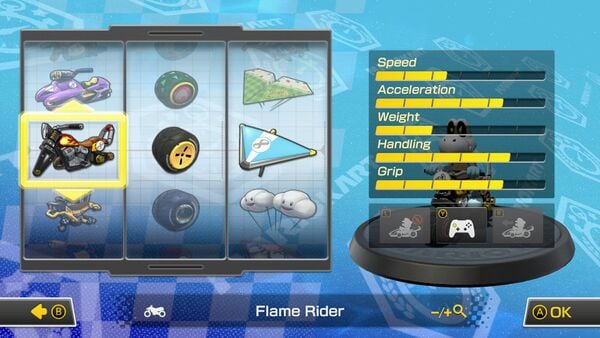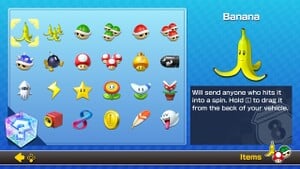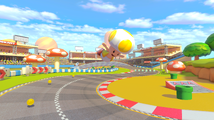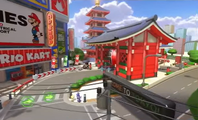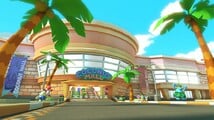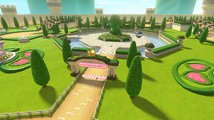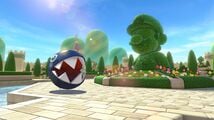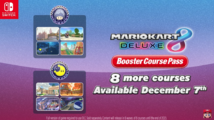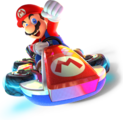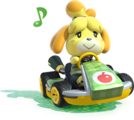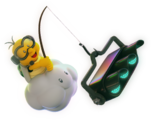Mario Kart 8 Deluxe
| Mario Kart 8 Deluxe | |||||||||||||||||||||||||||||
|---|---|---|---|---|---|---|---|---|---|---|---|---|---|---|---|---|---|---|---|---|---|---|---|---|---|---|---|---|---|
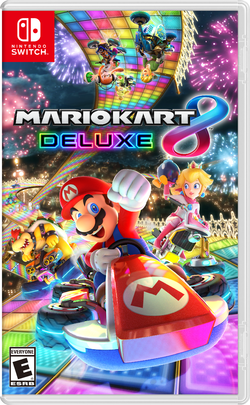 For alternate box art, see the related gallery. | |||||||||||||||||||||||||||||
| Developers | Nintendo EPD Bandai Namco Studios | ||||||||||||||||||||||||||||
| Publishers | Nintendo Tencent Games (China) | ||||||||||||||||||||||||||||
| Platform | Nintendo Switch | ||||||||||||||||||||||||||||
| Release dates | Mario Kart 8 Deluxe: Mario Kart 8 Deluxe + Booster Course Pass: | ||||||||||||||||||||||||||||
| Languages | English (United States) English (United Kingdom) Japanese Chinese (Simplified)SC Chinese (Traditional) Dutch French (Canada) French (France) German Italian Korean Portuguese (Portugal) Russian Spanish (Latin America) Spanish (Spain) SC - The global and domestic versions have slightly different localizations. | ||||||||||||||||||||||||||||
| Genre | Racing | ||||||||||||||||||||||||||||
| Ratings |
| ||||||||||||||||||||||||||||
| Modes | Single Player Multiplayer (2-4 players) Local Wireless Play (2-8 players) Online Play (2-12 players) LAN Play (2-12 players) | ||||||||||||||||||||||||||||
| Format | Nintendo Switch: | ||||||||||||||||||||||||||||
| Input | Nintendo Switch: | ||||||||||||||||||||||||||||
| Serial codes | Mario Kart 8 Deluxe: Mario Kart 8 Deluxe + Booster Course Pass: | ||||||||||||||||||||||||||||
Mario Kart 8 Deluxe is a racing game in the Mario Kart series released worldwide for the Nintendo Switch on April 28, 2017. It is an enhanced port of Mario Kart 8 for the Wii U and is the first Super Mario game overall to be released for the Nintendo Switch. The base game contains additional content such as several new characters and an overhauled Battle mode with new courses and modes. First teased in the Nintendo Switch's announcement video on October 20, 2016, the game was formally announced as part of the Nintendo Switch presentation on January 13, 2017.
Throughout 2022 and 2023, new race courses and returning characters were added to the game via the Mario Kart 8 Deluxe – Booster Course Pass paid DLC. An edition of the game that has the Booster Course Pass activated from the start, titled the Mario Kart 8 Deluxe Bundle (Game + Booster Course Pass), is available for purchase digitally.[9]
Controls
| Action | Dual Joy-Con Pro Controller |
Motion | Joy-Con (horizontal) |
Toy-Con Motorbike | Toy-Con Car | GameCube Controller |
|---|---|---|---|---|---|---|
| Steer | Tilt |
Tilt Toy-Con | ||||
| Accelerate / Rocket Start | Tilt |
Pedal (Half Press) | ||||
| Brake / Reverse | ||||||
| Item / Horn | ||||||
| Drift / Hop / Trick | Pedal (Full Press) | |||||
| Rear View | ||||||
Differences from the original
The following is a list of changes made to the base Mario Kart 8 Deluxe game from the latest version of Mario Kart 8, excluding changes that were fixed to be consistent with the original game in future updates.
General
- Characters, cups, and courses that were originally unlockable or exclusive to downloadable content in Mario Kart 8 are available from the start in this game; in addition, King Boo, Bowser Jr., Dry Bones, Inkling Boy, and Inkling Girl are added as new characters. This makes for the largest starting character roster or track selection of any home console Mario Kart game.
- Metal Mario gains an alternate costume known as Gold Mario, which is unlocked by clearing all cups in 200cc.
- A new Inkling Suit has been added to the Mii racing suits roster. It is usable by scanning an Inkling or Splatoon-series amiibo. In addition, the Animal Crossing Suit can be unlocked with any Isabelle or Animal Crossing-series amiibo.
- The game has reduced loading times.
Gameplay
- The Battle mode has been revamped.
- The overall game difficulty has been adjusted, as CPUs slow down when close to the player and do not charge Mini-Turbos or Super Mini-Turbos as quickly.
- The default speed of the CPUs in the Normal and Easy difficulties is slightly reduced.
- The rival system has been expanded: characters that did not have any in the original were given them, and characters who already had them swapped some in place of others.
- Motion controls are now turned on in the pause menu by pressing
, rather than a toggle switching between it and stick controls.
- This game introduces Smart Steering and Auto-Accelerate for beginners; the former makes staying on the track easier by automatically steering the vehicle away from edges on the track, while the latter makes the vehicle automatically accelerate (though this is not available in Battle mode). If the Smart Steering mode is on, the player's vehicle will have a black antenna sticking out of its rear end; this antenna blinks yellow and bends when Smart Steering is in effect. Smart Steering and Auto-Accelerate can be toggled on and off individually for each player in the vehicle part selection menu and in the pause menu.
- The pathfinding and drifting of CPUs in 200cc was reworked.
- The unlock criteria for various kart parts have been adjusted; some now have to be unlocked instead of being obtained from the start, while others are now obtained from the start instead of being unlockable. All kart parts that were DLC in the original game are now unlocked in the same manner as non-gold kart parts. New kart parts have been added, such as the Koopa Clown, the Inkstriker, and the Splat Buggy.
- Turning off the map, which is now turned on by default, is done by pressing
in the pause menu, instead of
 at any time like in the original.
at any time like in the original. - There is an additional level of Mini-Turbo, called Ultra Mini-Turbo, denoted by purple sparks (referred to as pink in the British English version) that appear after the orange sparks. This new level of Mini-Turbo can only be used if Smart Steering is off.
- A 200cc engine class in Time Trials was added; in addition to being separately recorded from the 150cc Time Trials, it features new staff ghosts.
- Some of the staff ghosts in time trials from the Wii U version were adjusted.
- There are more character weight classes than in the original, with several returning characters having different statistics.
- The player can now change controllers on the character selection screen by pressing
or
.
- The statistics of vehicle parts have been altered, and certain physics elements, such as the speed increase per stat and the acceleration tiers, were adjusted.
- Wireless and LAN modes were added, the latter returning from Mario Kart: Double Dash!!
- The minimum number of races and rounds in a VS Race or Battle is now four instead of three.
- The maximum number of races and rounds in a VS Race or Battle is now 48 and 25 respectively instead of 32 in both modes.
- CPUs choose from a wider variety of kart parts than in the original version.
- Being able to see which items the other drivers have, which was only possible when playing with the Wii U GamePad in the original, has now been removed entirely.
- Miiverse compatibility is absent, including the ability to upload Highlight Reels on YouTube; this feature was also discontinued in the Wii U version when Miiverse was terminated on November 7, 2017.
- An exploit in the original version that allowed players to gain speed by hopping after speed boosting has been fixed.
Items
- Characters can now carry up to two items at once, even if they do not equip the first item.
- The game features the return of the Double Item Box from Mario Kart: Double Dash!!
- Red Shells and Spiny Shells are now slower when they lock onto their target, meaning players are able to outrun them in 200cc when they have any kind of speed boost.
- Items are now based on distance and placement, rather than distance alone.
- The Boo is introduced as an item, with the Feather also appearing in Battle mode only.
- If a Blooper is about to ink the player as they cross the finish line, the player will now still get inked.[10] This is unlike the Wii U version, where the Blooper or the ink disappeared instead.
- CPUs now have a chance to obtain Triple Red Shells from Item Boxes, but this primarily only happens in the Shells Only item setting.
Online
- Playing online now requires a subscription to Nintendo Switch Online, rather than being tied to Nintendo Network.
- The dedicated lobbies for DLC copies and non DLC copies from the original game have been removed, as has the option to set whether or not tournament lobbies could be set to only allow the latter.
- Online lobbies have been changed in that a room entirely made up of players between 1000 VR and 3000 VR will be randomized between a 100cc or 150cc race, and a room full of players at over 3000 VR will be randomized among a 150cc, Mirror, or 200cc race, though the game normally selects 150cc. This is unlike the original game, where lobbies full of players between 1000 and over 4000 VR were put in 100cc, and lobbies full of players at over 5000 VR raced in 150cc.
- There is now an option to change character and kart parts in a lobby; this is done by pressing
during the course selection of an online lobby.
- Players are no longer positioned based on the order they joined.
- VR and BR distributions are slightly tweaked.
- Voice chat in private lobbies has been removed due to the Nintendo Switch's lack of a microphone.
Graphics
- The game now mostly renders in native 1920x1080 resolution in TV mode (sometimes switching to native 1728x972), and always renders at native 1280x720 resolution in tabletop and handheld mode, instead of the dynamic 1280x720/1152x648 rendering resolution used in the original Wii U version. This makes Mario Kart 8 Deluxe the first Super Mario title to render in native 1080p.
- The game runs at a constant 60 FPS, whereas the Wii U version would frequently dip to 59.
- The shadows present in the game are more detailed in multiplayer.
- Trophies can no longer be rotated, even when in handheld mode.
- All courses that feature confetti flying around the finish line, such as Mario Circuit, now also have confetti on the ground of the course near it.[11]
- When using the rear-view mirror, the character will now move their eyes slightly to the left to look back, like in Mario Kart Wii; however, their eyes will stay looking to the left as long as the rear-view is active, rather than switching back after a second as they do in Mario Kart Wii.
- When playing with teams, flags colored to correspond to the teams are added behind the vehicles. If Smart Steering is on, then the Smart Steering antenna serves as the pole of the flag. These flags do not appear in Balloon Battle and Bob-omb Blast, as the colors of the balloons represent the teams in these modes.
- The Mii characters that represent the players in online lobbies wear racing suits, unlike in the original version in which they wore their regular outfits.
- The wireless and LAN modes use a very similar lobby to the online lobby, albeit visually set in a garage rather than on a globe.
- In online play, the Mii of the previous race or battle's winner wears a crown identical to the one worn by the first-place player in Battle mode.
- Motion blur when boosting is added to online play; in earlier builds, it was also present in splitscreen multiplayer.[12]
HUD / interface
- The user interface on the title screen and main menu has been revamped.
- All of the Toad icons are now on the left.
- The mode buttons appear longer, wider, and more spaced out.
- The options for playing online with one or two players have been combined, with the mode being renamed to "Online Play" due to this.
- For local multiplayer, there is now a sub-menu to choose the number of players to participate with.
- The new wireless and LAN modes were added to the menu. They use a very similar lobby to the online lobby, albeit set in a garage rather than on a globe.
- The Nintendo eShop icon that led to the DLC's shop page has been removed.
- The stamp counter icon has been removed.
- The status screen and amiibo menu, brought up by pressing
 and
and  on Wii U respectively, now have their own dedicated icons on the bottom, replacing the prompts to open the equivalent menus from the Wii U game. Both menus have also been redesigned.
on Wii U respectively, now have their own dedicated icons on the bottom, replacing the prompts to open the equivalent menus from the Wii U game. Both menus have also been redesigned. - The Mario Kart TV icon was relocated from beneath the online play button on Wii U to being on the right of the amiibo icon.
- Much of the artwork on the entire menu was replaced and, after being unlocked, swaps out every time the game is opened.
- The game features an in-game guide, directly accessible from the game's menu; this guide explains various techniques, Battle mode, and the functions of each item. Much of its text is reused from the Wii U version's electronic manual.
- The menu in VS Race was redesigned.
- Scrollbars have been removed from the time trial menu. It also no longer shows Miiverse posts.
- Race rules and the course name are now displayed on loading screens in online matches.
- New tournament icons have been added in online play.
- The game no longer shows the state or province a player is located in on the loading screen of an online match or the loading screen in Mario Kart TV.
- In online matches, the flag displaying the country a player is in has been resized to be as big as the Mii icon next to it, as well as to display at a higher resolution.
- Players can now see the lap count or timer when spectating an online race or battle respectively.
- In races, the lap and coin counters have been moved closer to the bottom left corner.
- It is no longer possible to see the lap count when crossing the finish line or the full results in multiplayer (including online lobbies) at the end of the race while watching Highlight Reels via Mario Kart TV.
- The minimap features multiple alterations. When playing in local multiplayer, there is only one map in the center of the screen, rather than each player having their own copy of it like in the Wii U version. The color for the race courses in the Wii U version was typically blue, excluding the maps of the Rainbow Roads and GCN Baby Park, which were rainbow and red, respectively. However, in this version, all minimaps are white, like in Mario Kart Wii and Mario Kart 7. Battle courses now have color-shaded areas and lines on their maps to serve as a visual representation of where the player is located. In a race, the player in first place no longer has a crown on their map icon, though they still do in battles. The icons for characters and the Spiny Shell on the course map are now slightly larger, more detailed, and of an increased resolution. Explosions caused by Spiny Shells and Bob-ombs are also now shown. From the Booster Course Pass onwards, the minimaps are generally rotated such that the starting line is facing upwards.
- All notifications use a different font.
- It is now possible to check which kart parts a ghost was using in time trials.
- Inkling Girl, Isabelle, and Link now appear on the loading screen, replacing the second set of characters from Wario to Bowser.
- The chart on the kart selection screen no longer rounds to the nearest whole number, creating a more accurate representation of the karts' stats.[13]
- The engine class for the upcoming race in an online race lobby is now shown in the lobby as the course is selected, via a "50", "100", "150", mirrored "150" (for Mirror), or "200" icon in the bottom right of the selected course icon.
- This extends to online battle lobbies, which will display a symbol of a yellow balloon (for Balloon Battle), a potted Piranha Plant (for Renegade Roundup), a coin (for Coin Runners), a Shine Sprite (for Shine Thief), or a Bob-omb (for Bob-omb Blast) to denote which Battle mode is about to be played.
Audio
- The game supports 5.1 surround. Effects that can play on the rear speakers include approaching shells, certain vehicles' engines, sceneries (e.g. bats, falling rocks, water, helicopters), and if other drivers are immediately to the side. Background music, Lakitu's countdowns, and menu sounds are mixed to stereo only. Some surround receiver producers' models may default to Standard modes that water out the effect (e.g. playing background music via side speakers), necessitating switching them to Straight/Direct or upmixing modes.
- Characters no longer vocally react to being inked by a Blooper.
- The faster variation of the course's theme in Battle mode now begins a minute before ending, rather than 30 seconds before.
Battle
The biggest change made between Mario Kart 8 Deluxe and the original release of Mario Kart 8 is the Battle mode. Battle mode now returns to the arena-based style, adding eight new battle courses, each with its own course intro (replacing the eight Battle mode race tracks from Mario Kart 8) and unlike previous games, each player starts with five balloons, as opposed to three. Another addition to Battle mode is that the character in the lead now wears a crown, unlike in Mario Kart 8 where the crown is displayed only on the HUD map. Additionally, players now start out with zero points instead of Mario Kart 8's default three points, and their balloons do not serve as the remaining three points.
Returning from Mario Kart Wii and Mario Kart 7 is the ability to respawn after all balloons are popped; this causes the player's total score to halve and the player respawns with three balloons instead of five. A new addition to this mode is the feature to tell exactly which character hit whom, which appears on the bottom of the screen. After getting hit, players now have about 1.5 seconds of invincibility frames, unlike in Mario Kart 8. The item options also appear to have been updated; the item-specific options have been removed, while a new "Skilled Items" option is now available for selection; in this option, powerful items appear less frequently, similar to Mario Kart Wii's "Strategic" ("Basic" in the British English version) item option.
There are five different Battle mode types, with two of them (Renegade Roundup and Coin Runners) also featuring the "No Items" item option:
- Balloon Battle: The classic mode where players use items to pop opponents' balloons or steal them in order to score points. This mode now uses the point-based set-up seen in Mario Kart Wii, and Mario Kart 7, rather than the survival set-up of Mario Kart 8 and earlier installments prior to Mario Kart Wii.
- Renegade Roundup: A new mode in the vein of "cops and robbers", with the racers being divided into two teams. One team, known as "The Authorities", has to use Piranha Plant items (which are permanently attached to the front of their vehicle and only serve to capture the opposing team; they do not operate like the regular item) in order to capture players from the other team, known as "The Renegades". Captured Renegades are placed into one of several jail cells floating above various points on the stage. Remaining Renegades can free their teammates by driving over a key switch placed below the jail cells. The Renegades win if at least one member is still running free when time runs out, and the Authorities win if all of the Renegades get captured. All Authority team members also temporarily lose their ability to capture after being hit by an item and Renegades receive a speed boost and temporary immunity when they are freed from the cells.
- Bob-omb Blast: A returning mode from Mario Kart: Double Dash!!, in which players attack one another using Bob-ombs to score points and can carry up to 10 Bob-ombs. This version follows nearly all of the same rules as Balloon Battle, the differences being these: the only items are Bob-ombs, players cannot be hurt by their own Bob-ombs exploding, and Bob-ombs thrown forward explode instantly.
- Coin Runners: Originating in Mario Kart Wii, this mode was last seen in Mario Kart 7. Players must collect Coins scattered across the course in order to have the most by the end of the match. Plays more akin to the Mario Kart Wii version of the mode, with players having no limit to the amount of coins they can collect, as opposed to the 10-coin limit in the Mario Kart 7 version.
- Shine Thief: Another returning mode from Mario Kart: Double Dash!!, one player must retrieve a Shine Sprite and keep hold of it for about 20 seconds, while the opponents use items against whoever has the Shine to force that player to drop it. The driver holding the shine sprite has a slightly reduced top speed. In Team play, one team must collectively manage to hold on to the Shine for about 30 seconds.
There is also the option to randomly select one of the five available modes by choosing "Random Battle", which changes the Battle type after each round. The Round Count option has also been adjusted for Random Battle, with options for 5, 8, 10, 15, 20, and 25 rounds instead of 4, 6, 8, 12, 16, and 24 rounds from the separate Battle types.
Characters
There are a total of 50 playable characters in Mario Kart 8 Deluxe, including 42 in the base game and eight as DLC. The two Inklings and Villagers, despite having different stats, animations, and rivals compared to their counterparts, share slots with their counterparts as of version 3.0.0, bringing the total slots down to 48. All base and DLC characters from Mario Kart 8 are present in the base roster of Mario Kart 8 Deluxe and are now available from the start, while more characters that were not present in Mario Kart 8 are also added. The base game includes returning characters Bowser Jr., King Boo, and Dry Bones, who last appeared in the series as playable characters in Mario Kart Wii, and Gold Mario (as a variant of Metal Mario), who was previously playable in Mario Kart Arcade GP DX. It also introduces two new non-Super Mario characters, being the Inkling Girl and Inkling Boy from Splatoon. Both Inklings have three selectable colors each. At the game's launch, Inkling Girl and Inkling Boy took up separate slots on the character selection screen, as did the two Villagers, who were originally present in the same character slot (with the female Villager being a variant of the male one) in Mario Kart 8. However, with the version 3.0.0 update, Inkling Boy and female Villager now share slots with Inkling Girl and male Villager respectively. Despite sharing slots, female Villager and Inkling Boy can still appear in races if the other Villager or Inkling is present, and they continue to have different stats compared to their counterparts.[14]
Eight additional characters were added as downloadable content via the Booster Course Pass, starting with its fourth wave. Characters added include Birdo, who was added in Wave 4 with nine selectable colors, Petey Piranha, Wiggler, and Kamek, who were added in Wave 5, and Diddy Kong, Funky Kong, Pauline, and Peachette, who were added in Wave 6.[15] Wiggler, Gold Mario, Kamek, Pauline, Peachette, and all Birdo variants are playable for the first time in a home console Mario Kart installment. Kamek, Pauline, Peachette, and almost all Birdo variants were originally introduced in Mario Kart Tour, which released after Mario Kart 8 Deluxe. With Birdo's inclusion in Wave 4 and Diddy Kong and Funky Kong's inclusion in Wave 6, all playable characters from Mario Kart Wii are now included in Mario Kart 8 Deluxe.
There is only one unlockable character in this game, that being Gold Mario. He is unlocked by clearing all cups of the 200cc Grand Prix. Additionally, the version 1.6.0 update added a new variant for Link, Champion's Tunic Link,[16] based on his appearance in The Legend of Zelda: Breath of the Wild. When Gold Mario is unlocked and Champion's Tunic Link is downloaded, they become the default variations of their character, while Metal Mario and the version of Link based on his appearance in The Legend of Zelda: Skyward Sword are relegated to alternate costumes. As of the 3.0.0 update, however, the character select screen now remembers the last costume used for characters with alternate costumes.
There are more individual character weight classes when compared to the Wii U game, with several returning characters having different statistics, thus resulting in fewer characters having the same stats as each other.
Characters, variants, and Mii racing suits playable in this game that are not playable in the original Mario Kart 8 are listed in italics.
Character select screen with Gold Mario unlocked and all DLC characters downloaded
Character variants
With the exceptions of Link and the Villager, the displayed name of the character changes based on the variant that is selected. From version 3.0.0 onwards, the last used variant will have their icon shown on the character selection screen. Unlike in Mario Kart 8, the sub-menu for the two Villagers does not use a unique Animal Crossing-inspired color scheme, instead using the same gray color as the others.
1 - This variant is used as the select icon for the base character on the main select screen once it is available.
2 - Originally a separate character slot before being sharing a slot with another character in the version 3.0.0 update. Despite sharing slots, they have different stats, animations, and rivals compared to their counterparts.
3 - Originally the only version of the character before being relegated to a variant in the version 1.6.0 update.
Mii racing suits
All 20 Mii racing suits return from Mario Kart 8, and, like in that game, the color of the Normal Suit matches the favorite color of the selected Mii. There are also two additional Mii racing suits tied to scanning amiibo - the new Inkling Suit, which is unlocked either by scanning any Inkling or Splatoon-series amiibo, and the Daisy Suit, returning from Mario Kart Tour, which can be unlocked by scanning any Daisy amiibo after installing version 3.0.0. In addition, the Animal Crossing Suit can now be unlocked with any Isabelle or Animal Crossing-series amiibo, and the Pikmin Suit can be unlocked with Pikmin-series amiibo. In version 3.0.0, scanning any amiibo of characters in The Legend of Zelda, Metroid, and Kirby series unlocks the respective series' Mii racing suits.
- Normal suits
- amiibo suits
Mario Suit
Luigi Suit
Peach Suit
Yoshi Suit
Donkey Kong Suit
Hylian Suit
Captain Falcon Suit
Kirby Suit
Varia Suit
Fox Suit
Toad Suit
Bowser Suit
Wario Suit
Rosalina Suit
Pikmin Suit
Animal Crossing Suit
Mega Man Suit
PAC-MAN Suit
Sonic Suit
Inkling Suit
Daisy Suit (ver. 3.0.0)
- DLC suits (added in ver. 3.0.0)
As part of the sixth wave of the Booster Course Pass, 17 additional Mii racing suits from Mario Kart Tour were added. These costumes can be unlocked via purchasing the DLC.[14] Some Jump Boost animations from these suits are different from those of the standard and amiibo racing suits.
? Block Suit
Castle Suit
Toadette Suit
Dry Bowser Suit
Chain Chomp Suit
Cheep Cheep Suit
Dolphin Suit
Pokey Suit
Blooper Suit
Koopa Clown Car Suit
Para-Biddybud Suit
Ice Cream Suit
Birdo Suit
Petey Piranha Suit
Wiggler Suit
Goomba Suit
Moo Moo Suit
Rival order
Like in Mario Kart 8, characters have set rivals that consistently appear when racing in Grand Prix races. They are once again restricted to Grand Prix only, not appearing in single player VS Race or Battle mode. Unlike the previous game, more characters have rivals: the twelve characters from the previous game who had rivals retain their rivals in this game, while most other characters range from having one to two rivals each, though some still have none at all.
Vehicle parts
Mario Kart 8 Deluxe features six additional vehicle body parts. One is the Koopa Clown, returning from Mario Kart 7. Two new vehicles are Splatoon-based ATVs; the Splat Buggy and Inkstriker. These three change their colors for certain characters: the former for the Koopalings, and the latter two for all Inkling variations. Version 1.6.0 adds the Master Cycle Zero, Ancient Tires, and Paraglider. In total, there are 41 vehicle bodies, 22 tires, and 15 gliders, resulting in up to 13,530 different combinations.
Computer-controlled characters now choose from a wider variety of kart parts than in the original version, such as the Flame Rider and the Sports Coupe. However, they are still restricted to a set amount of body parts per character. A CPU Baby Daisy has the tendency to use the Wild Wiggler with Wood tires, for example.
The vehicle parts that were exclusive to downloadable content in Mario Kart 8 (i.e. parts included within the Mercedes-Benz × Mario Kart 8, The Legend of Zelda × Mario Kart 8, and Animal Crossing × Mario Kart 8 add-on packs) are now accessible in the base game and are randomly unlocked by collecting coins during gameplay.
The statistics of some vehicle parts have been altered, and certain physics elements, such as the speed increase per stat and the acceleration tiers, have been adjusted.
Available parts
The parts available are listed here in the order shown in the vehicle customization screen, with the following notation:
- Bold = Part is available at the start.
- * = Changes color, depending on the character.
- ** = Changes color for the Koopalings.
- *** = Changes color for Daisy, Baby Daisy, Rosalina, Baby Rosalina, Wiggler, Kamek, and Funky Kong.
- **** = Changes color for the Inklings.
- (DX) = Part is not available in the original Mario Kart 8.
- (NEW) = Part is introduced in this game.
The "8" logos on the parts are replaced with the driver's emblem, except on the Gold Standard and Gold Glider.
Karts
Biddybuggy*
BuggybudLandship**
Sneeker*
BounderSports Coupe
Sports CoupéGold Standard
Gold KartGLA*
Koopa Clown** (DX)
Standard bikes
Mr. Scooty
Mr ScootyMaster Cycle Zero (NEW)
Sport bikes
ATVs
Standard ATV*
Standard QuadSplat Buggy**** (NEW)
Inkstriker**** (NEW)
Tires
Standard
NormalWood
WoodenBlue Standard
Normal BlueHot Monster
Funky MonsterGold Tires
Gold WheelsGLA Tires
GLA WheelsTriforce Tires
Triforce TyresAncient Tires (NEW)
Ancient TyresLeaf Tires
Leaf Tyres
Gliders
Paraglider (NEW)
CPU combinations
All characters in the game besides Miis and most variants (with the exceptions of blue Inkling Boy, female Villager, and Link's alternate outfit) can be used by CPUs. Each of these characters have four different combinations of vehicle parts that they can use as CPUs:
| CPU combinations | ||||
|---|---|---|---|---|
| Character | Combination 1 | Combination 2 | Combination 3 | Combination 4 |
Drivers' and vehicle parts' statistics
- For the in-game tables from which these values were derived and for the tables to translate those values into the actual statistics used by the game, see Mario Kart 8 Deluxe in-game statistics.
Mario Kart 8 Deluxe features different statistics with respect to Mario Kart 8.
Statistics shown in the vehicle customization screen
Just like Mario Kart 7 and Mario Kart 8, the game uses "points" ("PT") which are conferred by characters and vehicle parts to determine the final values of the game's statistics. In each statistics, the points given by the character, body, tires, and glider are summed to obtain a final value called "Level" ("Lv") which is then used by a table to convert the level into appropriate physical parameters used by the game. There are a total of 8,064 different stat combinations. The Level of five statistics is displayed in the vehicle customization screen:
- Speed: The top speed of the vehicle on land with normal gravity.
- Acceleration: How fast the speed increases when holding the acceleration button until top speed has been reached.
- Weight: The weight of the vehicle. Vehicles with higher weight knock away vehicles with lower weight.
- Handling: The turning ability of the vehicle on land with normal gravity. A higher stat means vehicles turn sharper, and will continue turning normally for longer before automatically initiating a drift.
- Traction (Grip in the British English version): The grasp of the vehicle to the ground while off-road. Vehicles with higher traction slip less on certain terrain and can stay stable on the road better. Not to be confused with handling.
Said Level is represented through bars by adding three points to the sum of points, then dividing the result by four, resulting in values ranging from 0.75 to 5.75. As an example, the process through which the statistics of a certain combination of character and vehicle parts are calculated and displayed is shown below:
| Element | Points conferred | ||||
|---|---|---|---|---|---|
| Speed | Acceleration | Weight | Handling | Traction | |
Dry Bones |
2 | 5 | 1 | 8 | 4 |
| 2 | 5 | 1 | 4 | 5 | |
| 2 | 4 | 2 | 3 | 5 | |
| 1 | 1 | 1 | 1 | 1 | |
| Final values | Speed | Acceleration | Weight | Handling | Traction |
| Level | 2 + 2 + 2 + 1 = 7 |
5 + 5 + 4 + 1 = 15 |
1 + 1 + 2 + 1 = 5 |
8 + 4 + 3 + 1 = 16 |
4 + 5 + 5 + 1 = 15 |
| Value shown in the vehicle customization screen | (7 + 3) / 4 = 10 / 4 = 2.5 |
(15 + 3) / 4 = 18 / 4 = 4.5 |
(5 + 3) / 4 = 8 / 4 = 2 |
(16 + 3) / 4 = 19 / 4 = 4.75 |
(15 + 3) / 4 = 18 / 4 = 4.5 |
Drivers' statistics
Drivers are still grouped into small groups of characters sharing the same statistics, the number of groups has been increased with respect to Mario Kart 8.
In addition to the statistics shown in the vehicle customization screen, there are the following statistics:
- Water Speed: The top speed of the vehicle while driving underwater.
- Air Speed: The top speed of the vehicle while gliding.
- Anti-Gravity Speed: The top speed of the vehicle in anti-gravity mode.
- Water Handling: The turning ability of the vehicle while driving underwater.
- Air Handling: The turning ability of the vehicle while gliding.
- Anti-Gravity Handling: The turning ability of the vehicle in anti-gravity mode.
- Mini-Turbo: The length of the vehicle's mini-turbo speed boosts and how fast mini-turbos can be charged. Also affects the length of jump boosts from tricks.
- Invincibility: The length of time the vehicle is invincible after spinning out. Added in v2.2.0.[17]
Just like in Mario Kart 8, Miis can be Light, Medium, or Heavy, depending on their height and weight.
The statistics are shown in points.
Parts' statistics
The number of groups of vehicle parts sharing the same statistics has increased as well when compared with Mario Kart 8.
The statistics are reported in points. The invincibility statistic cells for vehicle bodies and tires are split up according to each part inside that row, from left to right. There is an unused stat for on-road traction, which can be viewed here.
| Bodies' Statistics | ||||||||||||||||
|---|---|---|---|---|---|---|---|---|---|---|---|---|---|---|---|---|
| Body *sport bike |
Speed | Acceleration | Weight | Handling | Traction | Mini-Turbo | Invincibility | |||||||||
| Ground | Water | Air | Anti-Gravity | Ground | Water | Air | Anti-Gravity | |||||||||
| 0 | 1 | 1 | 2 | 7 | 0 | 5 | 4 | 4 | 5 | 4 | 7 | 0 | 0 | |||
| 2 | 5 | 2 | 0 | 6 | 0 | 4 | 5 | 3 | 2 | 6 | 6 | 3 | 2 | |||
| 2 | 3 | 1 | 1 | 6 | 1 | 5 | 4 | 2 | 4 | 4 | 6 | 3 | 2 | 2 | ||
| 2 | 2 | 4 | 3 | 5 | 2 | 4 | 2 | 4 | 3 | 3 | 6 | 3 | 3 | 2 | 1 | |
| 2 | 2 | 3 | 4 | 5 | 1 | 4 | 3 | 3 | 4 | 5 | 5 | 4 | 4 | 4 | 4 | |
| 3 | 3 | 4 | 5 | 3 | 3 | 2 | 2 | 2 | 4 | 4 | 5 | 3 | 3 | 1 | ||
| 3 | 4 | 3 | 3 | 2 | 3 | 4 | 4 | 3 | 3 | 7 | 5 | 4 | 3 | 3 | ||
| 3 | 3 | 3 | 3 | 4 | 2 | 3 | 2 | 3 | 3 | 3 | 5 | 4 | 3 | 3 | ||
| 4 | 2 | 3 | 4 | 3 | 0 | 2 | 3 | 1 | 5 | 3 | 4 | 4 | 3 | |||
| 4 | 3 | 3 | 3 | 2 | 1 | 3 | 3 | 3 | 2 | 2 | 4 | 5 | 3 | 3 | ||
| 4 | 2 | 3 | 3 | 2 | 2 | 3 | 2 | 2 | 3 | 0 | 4 | 5 | 4 | 3 | ||
| 4 | 5 | 0 | 2 | 1 | 4 | 1 | 5 | 1 | 1 | 3 | 3 | 6 | 6 | 5 | ||
| 5 | 1 | 2 | 4 | 1 | 3 | 1 | 1 | 0 | 2 | 1 | 3 | 6 | 6 | 6 | ||
| 5 | 2 | 1 | 3 | 0 | 4 | 0 | 1 | 0 | 1 | 5 | 3 | 7 | 7 | 6 | ||
| Tires' Statistics | ||||||||||||||||
| Tire | Speed | Acceleration | Weight | Handling | Traction | Mini-Turbo | Invincibility | |||||||||
| Ground | Water | Air | Anti-Gravity | Ground | Water | Air | Anti-Gravity | |||||||||
| 0 | 3 | 3 | 0 | 6 | 0 | 4 | 4 | 4 | 4 | 4 | 6 | 0 | 0 | |||
| 1 | 2 | 2 | 2 | 5 | 0 | 3 | 3 | 2 | 4 | 3 | 5 | 3 | 3 | |||
| 1 | 1 | 4 | 1 | 4 | 1 | 2 | 1 | 3 | 2 | 6 | 5 | 6 | 4 | |||
| 2 | 3 | 3 | 2 | 4 | 2 | 3 | 3 | 3 | 3 | 5 | 4 | 5 | 4 | 4 | ||
| 3 | 2 | 2 | 4 | 2 | 2 | 4 | 4 | 4 | 3 | 1 | 3 | 5 | 5 | 5 | ||
| 3 | 2 | 1 | 2 | 2 | 4 | 0 | 1 | 1 | 0 | 7 | 3 | 6 | 6 | 5 | ||
| 3 | 4 | 1 | 2 | 3 | 3 | 1 | 1 | 2 | 2 | 6 | 3 | 6 | 6 | 6 | ||
| 4 | 0 | 0 | 4 | 1 | 3 | 2 | 0 | 1 | 2 | 0 | 2 | 5 | 5 | |||
| 4 | 3 | 2 | 1 | 0 | 4 | 2 | 2 | 0 | 1 | 2 | 2 | 6 | 5 | |||
| Gliders' Statistics | ||||||||||||||||
| Glider | Speed | Acceleration | Weight | Handling | Traction | Mini-Turbo | Invincibility | |||||||||
| Ground | Water | Air | Anti-Gravity | Ground | Water | Air | Anti-Gravity | |||||||||
| 0 | 1 | 1 | 1 | 2 | 0 | 1 | 0 | 2 | 1 | 1 | 2 | 0 | ||||
| 0 | 0 | 1 | 1 | 2 | 1 | 1 | 1 | 2 | 0 | 0 | 2 | 0 | ||||
| 1 | 0 | 2 | 1 | 1 | 2 | 1 | 1 | 1 | 0 | 0 | 1 | 1 | ||||
| 1 | 1 | 2 | 0 | 1 | 1 | 1 | 0 | 1 | 1 | 1 | 1 | 1 | ||||
Unlocking criteria
Gold Mario
The only unlockable playable character in this game is Gold Mario, who is unlocked by winning all twelve base-game gold cups at 200cc. Once unlocked, he replaces Metal Mario on the character select screen. Metal Mario is from then on treated as a color variant of Gold Mario. The two differ only in their color scheme and the voice clip used when selecting them. Their other voice clips, horn sounds, animations, and statistics are identical.
Vehicle parts
A vehicle part is randomly unlocked every 30 coins. Once reaching 450 coins this changes to every 50, and once reaching 1500 coins this changes to every 100. Eventually, the last non-gold vehicle part is unlocked on reaching 3100 coins.
Special parts
Special gold parts are unlocked with the following criteria:
- Gold Standard: Unlocked by achieving at least 1 star ranking on all base-game Mirror Cups.
- Gold Tires: Unlocked by defeating all 48 base-game staff ghosts in 150cc Time Trials.
- Gold Glider: Unlocked by collecting 5000 coins.
Alternate title screens
Additional title screens can appear when hovering over the single player and multiplayer options on the main menu. These are unlocked by obtaining a gold trophy in every base-game cup in Mirror and 200cc, after which the title screens used are randomly selected. These alternate title screens can appear on start-up, which causes a different voice clip to play corresponding to the character shown on the screen, replacing the usual clip of Mario yelling "Mario Kart 8!"
Courses
There are 48 race courses in the base game (including all four cups that were DLC in the original Mario Kart 8), these being the 25 courses introduced in the original game and 23 classic courses, which includes two courses from Super Mario Kart, three courses each from Mario Kart: Super Circuit, Mario Kart DS, and Mario Kart Wii, and four courses each from Mario Kart 64, Mario Kart: Double Dash!!, and Mario Kart 7. It is also the first Mario Kart game since Mario Kart 64 to have all courses available from the start.
Booster Course Pass
- Main article: Mario Kart 8 Deluxe – Booster Course Pass
The Mario Kart 8 Deluxe – Booster Course Pass DLC includes 48 additional courses (mostly classic courses), released in six waves of eight courses each, increasing the game's total number of courses to 96. The first wave released on March 18, 2022, and the final wave released on November 9, 2023. The classic courses in the DLC include two courses each from Super Mario Kart and Mario Kart 64, three courses from Mario Kart: Double Dash!!, four courses each from Mario Kart DS and Mario Kart 7, five courses from Mario Kart: Super Circuit, eight courses from Mario Kart Wii, and seventeen courses from Mario Kart Tour (making Mario Kart 8 Deluxe the first game in the series to feature classic courses of a Mario Kart game released after it), which increases the total number of courses from each game to four courses from Super Mario Kart, six courses from Mario Kart 64, seven courses each from Mario Kart: Double Dash!! and Mario Kart DS, eight courses each from Mario Kart: Super Circuit and Mario Kart 7, and eleven courses from Mario Kart Wii. Three new courses are also included, namely Sky-High Sundae, Yoshi's Island, and Squeaky Clean Sprint, increasing the total number of new courses to 28.
In the British English version of the game, 3DS Rock Rock Mountain and Wii DK Summit are known as 3DS Alpine Pass and Wii DK's Snowboard Cross respectively, as was the case in the British English versions of their original appearances. However, most courses that had different names between European French and Canadian French in previous games instead use their European French names in both versions, with the exceptions of DS Waluigi Pinball, Tour Amsterdam Drift, and 3DS Rosalina's Ice World.
- ^ Titled "Toad Harbour" in the British English version.
- ^ Titled "Bone Dry Dunes" in the British English version.
- ^ Titled "3DS Melody Motorway" in the British English version, as in Mario Kart 7.
- ^ Titled "3DS Piranha Plant Pipeway" in the British English version, as in Mario Kart 7.
- ^ Titled "3DS Koopa City" in the British English version, as in Mario Kart 7.
- ^ Titled "3DS Alpine Pass" in the British English version, as in Mario Kart 7.
- ^ Titled "Wii DK's Snowboard Cross" in the British English version, as in Mario Kart Wii.
Battle courses
Eight battle courses are present in Mario Kart 8 Deluxe, five new and three classic, replacing the repurposed race courses used for Battle mode in the Wii U version.
Most battle courses visually resemble race courses from Mario Kart 8: Battle Stadium with Mario Kart Stadium, Sweet Sweet Kingdom with Sweet Sweet Canyon, Dragon Palace with Dragon Driftway, Lunar Colony with Rainbow Road, GCN Luigi's Mansion with Twisted Mansion, and SNES Battle Course 1 with SNES Donut Plains 3, all sharing similar textures and/or assets. 3DS Wuhu Town and GCN Luigi's Mansion, which shared music with other new battle courses in their debut games, were given new unique music.
Similar to regular races, a course introduction scene is now added at the start.
Battle Stadium |
Sweet Sweet Kingdom |
Dragon Palace |
Lunar Colony |
3DS Wuhu Town |
GCN Luigi's Mansion |
SNES Battle Course 1 |
Urchin Underpass |
Staff Ghosts
150cc Staff Ghosts
In Mario Kart 8 Deluxe, the times for staff ghosts in 150cc are slightly different from the original Mario Kart 8. Also, unlike the original game, players will not unlock any stamps if they beat the ghosts.
| Course | Staff Name | Country | Time | Character | Vehicle Combination | ||
|---|---|---|---|---|---|---|---|
| Body | Tires | Glider | |||||
| Mario Kart Stadium | Nin★Chris | United Kingdom | 1:53.191 | Mario | Sports Coupe | Standard | Super Glider |
| Water Park | Nin★Massim | Italy | 2:02.186 | Baby Luigi | Mr. Scooty | Roller | Super Glider |
| Sweet Sweet Canyon | Nin★Fausti | France | 2:07.205 | Baby Peach | Teddy Buggy | Wood | Peach Parasol |
| Thwomp Ruins | Nin★Sophia | Germany | 2:12.125 | Donkey Kong | Standard ATV | Monster | Super Glider |
| Mario Circuit | Nin★Sho | Japan | 2:08.501 | Mario | Standard Kart | Standard | Super Glider |
| Toad Harbor | Nin★Alice | United States | 2:29.282 | Toadette | Cat Cruiser | Retro Off-Road | Plane Glider |
| Twisted Mansion | Nin★Mark | Netherlands | 2:14.615 | Luigi | Mach 8 | Slim | Super Glider |
| Shy Guy Falls | Nin★Frank | United Kingdom | 2:21.804 | Shy Guy | Flame Rider | Off-Road | Super Glider |
| Sunshine Airport | Nin★Leonel | United States | 2:20.447 | Rosalina | Circuit Special | Standard | Super Glider |
| Dolphin Shoals | Nin★Skip | United States | 2:14.832 | Wendy | Landship | Wood | Bowser Kite |
| Electrodrome | Nin★Yuya | Japan | 2:21.023 | Larry | Sport Bike | Monster | Super Glider |
| Mount Wario | Nin★Elena | Russia | 2:03.483 | Waluigi | The Duke | Monster | Wario Wing |
| Cloudtop Cruise | Nin★Maria | Portugal | 2:19.568 | Baby Rosalina | Biddybuggy | Standard | Super Glider |
| Bone-Dry Dunes | Nin★Elena | Russia | 2:15.338 | Morton | Tri-Speeder | Monster | Super Glider |
| Bowser's Castle | Nin★Polly | United Kingdom | 2:21.980 | Bowser | Badwagon | Standard | Super Glider |
| Rainbow Road | Nin★Mizuho | Japan | 2:25.267 | Pink Gold Peach | Comet | Slim | Super Glider |
| Wii Moo Moo Meadows | Nin★Chris | United Kingdom | 1:41.846 | Daisy | Varmint | Hot Monster | Super Glider |
| GBA Mario Circuit | Nin★Rie | Japan | 1:44.593 | Baby Mario | Yoshi Bike | Standard | Super Glider |
| DS Cheep Cheep Beach | Nin★Massim | Italy | 2:06.314 | Koopa Troopa | Steel Driver | Metal | Parachute |
| N64 Toad's Turnpike | Nin★Alice | United States | 2:08.966 | Toad | Standard Bike | Standard | Parachute |
| GCN Dry Dry Desert | Nin★Maria | Portugal | 2:26.614 | Peach | Standard Bike | Slim | Super Glider |
| SNES Donut Plains 3 | Nin★Frank | United Kingdom | 1:35.564 | Lakitu | Pipe Frame | Monster | MKTV Parafoil |
| N64 Royal Raceway | Nin★Skip | United States | 2:18.307 | Peach | Prancer | Wood | Peach Parasol |
| 3DS DK Jungle | Nin★Rie | Japan | 2:20.006 | Donkey Kong | Varmint | Monster | Waddle Wing |
| DS Wario Stadium | Nin★Mizuho | Japan | 2:09.171 | Wario | Tri-Speeder | Off-Road | Wario Wing |
| GCN Sherbet Land | Nin★Fausti | France | 2:20.174 | Lemmy | Sneeker | Standard | Super Glider |
| 3DS Music Park | Nin★Sho | Japan | 2:19.675 | Baby Daisy | Biddybuggy | Standard | Super Glider |
| N64 Yoshi Valley | Nin★Mark | Netherlands | 2:23.688 | Yoshi | Wild Wiggler | Standard | Flower Glider |
| DS Tick-Tock Clock | Nin★Sophia | Germany | 2:06.485 | Iggy | Standard Bike | Monster | Super Glider |
| 3DS Piranha Plant Slide | Nin★Polly | United Kingdom | 2:21.321 | Ludwig | Jet Bike | Slim | Super Glider |
| Wii Grumble Volcano | Nin★Yuya | Japan | 2:16.524 | Roy | Badwagon | Off-Road | Super Glider |
| N64 Rainbow Road | Nin★Leonel | United States | 1:33.981 | Metal Mario | Standard ATV | Monster | Super Glider |
| GCN Yoshi Circuit | Nin★Adrien | France | 2:07.557 | Red Yoshi | B Dasher | Standard | Super Glider |
| Excitebike Arena | Nin★Pedro | Spain | 1:58.808 | Mario | Standard Bike | Slim | Super Glider |
| Dragon Driftway | Nin★Mitsu | Japan | 2:05.957 | Lakitu | Varmint | Monster | Cloud Glider |
| Mute City | Nin★Laura | United States | 2:10.167 | Mario | Blue Falcon | Roller | Super Glider |
| Wii Wario's Gold Mine | Nin★Pit | Germany | 2:22.119 | Wario | Standard Kart | Monster | Super Glider |
| SNES Rainbow Road | Nin★Anne | Netherlands | 1:40.711 | Cat Peach | Cat Cruiser | Retro Off-Road | Super Glider |
| Ice Ice Outpost | Nin★Pavel | Russia | 2:09.427 | Tanooki Mario | Tanooki Kart | Monster | Super Glider |
| Hyrule Circuit | Nin★Mitsu | Japan | 2:08.616 | Link | Master Cycle | Triforce Tires | Hylian Kite |
| GCN Baby Park | Nin★Joost | Netherlands | 1:16.561 | Baby Mario | Biddybuggy | Standard | Super Glider |
| GBA Cheese Land | Nin★Aracel | Spain | 2:06.316 | Orange Yoshi | Pipe Frame | Monster | Parafoil |
| Wild Woods | Nin★Akira | Japan | 2:05.396 | Villager (Boy) | Streetle | Leaf Tires | Paper Glider |
| Animal Crossing | Nin★Marie | United States | 1:53.584 | Isabelle | City Tripper | Slim | Paper Glider |
| 3DS Neo Bowser City | Nin★Rui | Portugal | 2:13.138 | Dry Bowser | Bone Rattler | Metal | Super Glider |
| GBA Ribbon Road | Nin★Giulia | Italy | 2:07.152 | Villager (Girl) | Teddy Buggy | Button | Super Glider |
| Super Bell Subway | Nin★Juliet | France | 2:06.487 | Pink Shy Guy | City Tripper | Slim | Super Glider |
| Big Blue | Nin★Dylan | United Kingdom | 1:37.316 | Mario | P-Wing | Blue Standard | Super Glider |
| Tour Paris Promenade | Nin★Adrien | France | 2:07.401 | Peach | Standard Kart | Slim | Peach Parasol |
| 3DS Toad Circuit | Nin★Sho | Japan | 1:33.670 | Toad | Mr. Scooty | Azure Roller | Super Glider |
| N64 Choco Mountain | Nin★Massim | Italy | 2:08.949 | Koopa Troopa | Biddybuggy | Standard | Super Glider |
| Wii Coconut Mall | Nin★Skip | United States | 1:58.401 | Baby Mario | Sneeker | Metal | Super Glider |
| Tour Tokyo Blur | Nin★Yuya | Japan | 1:36.317 | Blue Inkling Boy | Splat Buggy | Blue Standard | Super Glider |
| DS Shroom Ridge | Nin★Frank | United Kingdom | 2:09.148 | Bowser | Bone Rattler | Off-Road | Super Glider |
| GBA Sky Garden | Nin★Pedro | Spain | 1:42.267 | Lakitu | P-Wing | Retro Off-Road | Cloud Glider |
| Ninja Hideaway | Nin★Fausti | France | 2:20.813 | Black Shy Guy | Standard ATV | Standard | Super Glider |
| Tour New York Minute | Nin★Leonel | United States | 1:34.573 | Donkey Kong | Varmint | Monster | Super Glider |
| SNES Mario Circuit 3 | Nin★Mark | Netherlands | 1:46.806 | Mario | B Dasher | Standard | Super Glider |
| N64 Kalimari Desert | Nin★Pit | Germany | 1:40.363 | Dry Bones | Standard Kart | Monster | Super Glider |
| DS Waluigi Pinball | Nin★Chris | United Kingdom | 2:36.450 | Waluigi | The Duke | Monster | Super Glider |
| Tour Sydney Sprint | Nin★Rie | Japan | 2:16.617 | Baby Mario | Biddybuggy | Standard | Super Glider |
| GBA Snow Land | Nin★Maria | Portugal | 1:46.763 | Tanooki Mario | Tanooki Kart | Standard | Super Glider |
| Wii Mushroom Gorge | Nin★Massim | Italy | 1:50.666 | Toadette | Teddy Buggy | Wood | Super Glider |
| Sky-High Sundae | Nin★Akira | Japan | 2:07.380 | Rosalina | Circuit Special | Standard | Super Glider |
| Tour London Loop | Nin★Frank | United Kingdom | 2:20.500 | Mario | Comet | Slim | Super Glider |
| GBA Boo Lake | Nin★Rie | Japan | 1:36.212 | King Boo | Circuit Special | Monster | Super Glider |
| 3DS Rock Rock Mountain | Nin★Fausti | France | 2:24.730 | Morton | Pipe Frame | Monster | Super Glider |
| Wii Maple Treeway | Nin★Pavel | Russia | 2:36.581 | Daisy | Prancer | Off-Road | Super Glider |
| Tour Berlin Byways | Nin★Sophia | Germany | 2:11.001 | Donkey Kong | Varmint | Monster | Super Glider |
| DS Peach Gardens | Nin★Marie | United States | 2:19.534 | Peach | Prancer | Wood | Super Glider |
| Merry Mountain | Nin★Elena | Russia | 2:09.693 | Shy Guy | Flame Rider | Off-Road | Super Glider |
| 3DS Rainbow Road | Nin★Mizuho | Japan | 1:52.015 | Rosalina | Circuit Special | Standard | Super Glider |
| Tour Amsterdam Drift | Nin★Mark | Netherlands | 1:48.580 | Daisy | Prancer | Wood | Super Glider |
| GBA Riverside Park | Nin★Frank | United Kingdom | 1:34.480 | Toad | Standard ATV | Standard | Super Glider |
| Wii DK Summit | Nin★Fausti | France | 2:22.680 | Donkey Kong | Varmint | Monster | Super Glider |
| Yoshi's Island | Nin★Skip | United States | 2:20.116 | Baby Mario | Biddybuggy | Standard | Super Glider |
| Tour Bangkok Rush | Nin★Yuya | Japan | 1:54.995 | Blue Inkling Boy | Inkstriker | Monster | Super Glider |
| DS Mario Circuit | Nin★Pit | Germany | 1:50.550 | Mario | B Dasher | Standard | Super Glider |
| GCN Waluigi Stadium | Nin★Maria | Portugal | 2:16.894 | Waluigi | The Duke | Monster | Super Glider |
| Tour Singapore Speedway | Nin★Alice | United States | 2:08.954 | Bowser | Badwagon | Monster | Super Glider |
| Tour Athens Dash | Nin★Pedro | Spain | 1:52.892 | Wiggler | Circuit Special | Sponge | Super Glider |
| GCN Daisy Cruiser | Nin★Chris | United Kingdom | 1:47.238 | Daisy | Jet Bike | Slim | Super Glider |
| Wii Moonview Highway | Nin★Yuya | Japan | 1:54.655 | Waluigi | The Duke | Monster | Wario Wing |
| Squeaky Clean Sprint | Nin★Fausti | France | 2:17.580 | Kamek | City Tripper | Cushion | Cloud Glider |
| Tour Los Angeles Laps | Nin★Alice | United States | 1:57.938 | Mario | Comet | Slim | Super Glider |
| GBA Sunset Wilds | Nin★Pit | Germany | 1:48.993 | Petey Piranha | Flame Rider | Off-Road | Flower Glider |
| Wii Koopa Cape | Nin★Massim | Italy | 2:18.943 | Koopa Troopa | Steel Driver | Metal | Super Glider |
| Tour Vancouver Velocity | Nin★Skip | United States | 2:11.072 | Rosalina | Sport Bike | Slim | Super Glider |
| Tour Rome Avanti | Nin★Giulia | Italy | 1:57.329 | Pauline | Badwagon | Metal | Super Glider |
| GCN DK Mountain | Nin★Laura | United States | 2:35.917 | Funky Kong | Standard ATV | Monster | Parafoil |
| Wii Daisy Circuit | Nin★Adrien | France | 2:01.099 | Daisy | Sports Coupe | Standard | Super Glider |
| Piranha Plant Cove | Nin★Sophia | Germany | 2:17.775 | Petey Piranha | Flame Rider | Slim | Flower Glider |
| Tour Madrid Drive | Nin★Aracel | Spain | 2:10.689 | Peachette | Biddybuggy | Standard | Cloud Glider |
| 3DS Rosalina's Ice World | Nin★Pavel | Russia | 2:10.993 | Rosalina | Sport Bike | Slim | Super Glider |
| SNES Bowser Castle 3 | Nin★Polly | United Kingdom | 1:54.632 | Bowser | Landship | Wood | Super Glider |
| Wii Rainbow Road | Nin★Leonel | United States | 2:49.574 | Mario | Standard Kart | Standard | Super Glider |
200cc Staff Ghosts
Mario Kart 8 Deluxe features a new option for players to race in Time Trials in the 200cc engine class. This option also features entirely new staff ghosts for each of the courses.
| Course | Staff Name | Country | Time | Character | Vehicle Combination | ||
|---|---|---|---|---|---|---|---|
| Body | Tires | Glider | |||||
| Mario Kart Stadium | Nin★Sophia | Germany | 1:21.984 | Gold Mario | Gold Standard | Gold Tires | Gold Glider |
| Water Park | Nin★Yuya | Japan | 1:22.799 | Baby Mario | Biddybuggy | Standard | Super Glider |
| Sweet Sweet Canyon | Nin★Alice | United States | 1:40.972 | Peach | Prancer | Wood | Peach Parasol |
| Thwomp Ruins | Nin★Skip | United States | 1:31.436 | Bowser | Badwagon | Standard | Bowser Kite |
| Mario Circuit | Nin★Joost | Netherlands | 1:23.243 | Pink Gold Peach | Standard Bike | Slim | Super Glider |
| Toad Harbor | Nin★Adrien | France | 1:43.003 | Toad | Sports Coupe | Standard | Super Glider |
| Twisted Mansion | Nin★Rui | Portugal | 1:38.244 | King Boo | Wild Wiggler | Sponge | Flower Glider |
| Shy Guy Falls | Nin★Anne | Netherlands | 1:40.698 | White Yoshi | Standard ATV | Retro Off-Road | Parafoil |
| Sunshine Airport | Nin★Sho | Japan | 1:45.437 | Luigi | Jet Bike | Metal | Plane Glider |
| Dolphin Shoals | Nin★Polly | United Kingdom | 1:38.911 | Ludwig | Steel Driver | Blue Standard | Bowser Kite |
| Electrodrome | Nin★Laura | United States | 1:40.943 | Roy | The Duke | Cushion | Parafoil |
| Mount Wario | Nin★Massim | Italy | 1:37.266 | Wario | Standard ATV | Crimson Slim | Wario Wing |
| Cloudtop Cruise | Nin★Giulia | Italy | 1:44.120 | Bowser Jr. | Koopa Clown | Cyber Slick | Cloud Glider |
| Bone-Dry Dunes | Nin★Pavel | Russia | 1:39.330 | Dry Bones | Pipe Frame | Wood | Plane Glider |
| Bowser's Castle | Nin★Mark | Netherlands | 1:40.953 | Dry Bowser | Flame Rider | Slim | Bowser Kite |
| Rainbow Road | Nin★Pedro | Spain | 1:55.767 | Rosalina | Mach 8 | Blue Standard | MKTV Parafoil |
| Wii Moo Moo Meadows | Nin★Leonel | United States | 1:09.980 | Baby Daisy | Sneeker | Cyber Slick | MKTV Parafoil |
| GBA Mario Circuit | Nin★Pit | Germany | 1:10.475 | Baby Luigi | Sport Bike | Slick | Parachute |
| DS Cheep Cheep Beach | Nin★Mizuho | Japan | 1:25.089 | Lakitu | Landship | Metal | Cloud Glider |
| N64 Toad's Turnpike | Nin★Rie | Japan | 1:21.156 | Toadette | Sports Coupe | Slick | Super Glider |
| GCN Dry Dry Desert | Nin★Chris | United Kingdom | 1:45.087 | Lemmy | Tanooki Kart | Off-Road | Super Glider |
| SNES Donut Plains 3 | Nin★Mizuho | Japan | 1:11.794 | Koopa Troopa | Streetle | Monster | Flower Glider |
| N64 Royal Raceway | Nin★Dylan | United Kingdom | 1:43.120 | Baby Peach | Circuit Special | Cyber Slick | Parafoil |
| 3DS DK Jungle | Nin★Polly | United Kingdom | 1:46.758 | Yellow Yoshi | City Tripper | Hot Monster | Paper Glider |
| DS Wario Stadium | Nin★Massim | Italy | 1:39.724 | Waluigi | Varmint | Hot Monster | Wario Wing |
| GCN Sherbet Land | Nin★Sophia | Germany | 1:34.370 | Iggy | Bone Rattler | Monster | Bowser Kite |
| 3DS Music Park | Nin★Mitsu | Japan | 1:36.529 1:38.847TC |
Daisy | Badwagon | GLA Tires Off-RoadTC |
MKTV Parafoil |
| N64 Yoshi Valley | Nin★Yuya | Japan | 1:35.628 | Green Shy Guy | Comet | Slim | Super Glider |
| DS Tick-Tock Clock | Nin★Elena | Russia | 1:32.483 | Larry | Standard Kart | Sponge | Paper Glider |
| 3DS Piranha Plant Slide | Nin★Frank | United Kingdom | 1:48.454 | Wendy | Mr. Scooty | Metal | Peach Parasol |
| Wii Grumble Volcano | Nin★Maria | Portugal | 1:44.284 | Morton | Standard Bike | Cushion | Parachute |
| N64 Rainbow Road | Nin★Fausti | France | 1:08.128 | Mario | Tri-Speeder | Monster | Super Glider |
| GCN Yoshi Circuit | Nin★Elena | Russia | 1:38.869 | Light-blue Shy Guy | P-Wing | Slick | Parachute |
| Excitebike Arena | Nin★Akira | Japan | 1:29.202 | Inkling Girl | Inkstriker | Leaf Tires | Super Glider |
| Dragon Driftway | Nin★Aracel | Spain | 1:34.873 | Purple Inkling Boy | Splat Buggy | Blue Standard | Super Glider |
| Mute City | Nin★Sho | Japan | 1:34.273 | Metal Mario | Blue Falcon | Azure Roller | Parafoil |
| Wii Wario's Gold Mine | Nin★Alice | United States | 1:41.168 | Waluigi | Standard Bike | Retro Off-Road | Wario Wing |
| SNES Rainbow Road | Nin★Marie | United States | 1:12.762 1:12.696TC |
Tanooki Mario | GLA Pipe FrameTC |
GLA Tires StandardTC |
Parachute |
| Ice Ice Outpost | Nin★Juliet | France | 1:32.435 | Cat Peach | Sneeker | Off-Road | Peach Parasol |
| Hyrule Circuit | Nin★Mark | Netherlands | 1:40.394 | Link | Master Cycle | Triforce Tires | Hylian Kite |
| GCN Baby Park | Nin★Leonel | United States | 0:59.765 | Baby Rosalina | Teddy Buggy | Cyber Slick | Waddle Wing |
| GBA Cheese Land | Nin★Chris | United Kingdom | 1:41.248 | Donkey Kong | Streetle | Roller | Flower Glider |
| Wild Woods | Nin★Mitsu | Japan | 1:27.555 | Villager (Girl) | City Tripper | Leaf Tires | Paper Glider |
| Animal Crossing | Nin★Fausti | France | 1:23.417 1:23.491TC |
Villager (Boy) | 300 SL Roadster StreetleTC |
GLA Tires StandardTC |
Super Glider |
| 3DS Neo Bowser City | Nin★Massim | Italy | 1:37.526 | Bowser | Bone Rattler | Standard | Super Glider |
| GBA Ribbon Road | Nin★Maria | Portugal | 1:31.220 | Isabelle | Cat Cruiser | Crimson Slim | Paper Glider |
| Super Bell Subway | Nin★Skip | United States | 1:23.304 | Blue Yoshi | Yoshi Bike | Blue Standard | Super Glider |
| Big Blue | Nin★Rie | Japan | 1:13.516 1:13.200TC |
Luigi | W 25 Silver Arrow Blue FalconTC |
Slim | Plane Glider |
| Tour Paris Promenade | Nin★Joost | Netherlands | 1:27.101 | Rosalina | Comet | Slim | Super Glider |
| 3DS Toad Circuit | Nin★Aracel | Spain | 1:03.969 | Toadette | Prancer | Wood | Super Glider |
| N64 Choco Mountain | Nin★Alice | United States | 1:31.715 | Tanooki Mario | Tanooki Kart | Monster | Super Glider |
| Wii Coconut Mall | Nin★Polly | United Kingdom | 1:29.009 | Baby Luigi | Yoshi Bike | Slick | Parachute |
| Tour Tokyo Blur | Nin★Aracel | Spain | 1:07.560 | Inkling Girl | Inkstriker | Metal | Super Glider |
| DS Shroom Ridge | Nin★Akira | Japan | 1:37.626 | Morton | Standard Bike | Cushion | Parachute |
| GBA Sky Garden | Nin★Rui | Portugal | 1:13.606 | Ludwig | Steel Driver | Blue Standard | Bowser Kite |
| Ninja Hideaway | Nin★Giulia | Italy | 1:37.815 | Black Yoshi | Teddy Buggy | Standard | Super Glider |
| Tour New York Minute | Nin★Sho | Japan | 1:07.562 | Yoshi | Sports Coupe | Standard | Super Glider |
| SNES Mario Circuit 3 | Nin★Giulia | Italy | 1:17.075 | Luigi | Mach 8 | Slim | Super Glider |
| N64 Kalimari Desert | Nin★Juliet | France | 1:10.511 | Dry Bowser | Bone Rattler | Monster | Super Glider |
| DS Waluigi Pinball | Nin★Pavel | Russia | 2:00.942 | Morton | Pipe Frame | Monster | Super Glider |
| Tour Sydney Sprint | Nin★Giulia | Italy | 1:37.367 | Bowser Jr. | Koopa Clown | Standard | Super Glider |
| GBA Snow Land | Nin★Leonel | United States | 1:21.826 | King Boo | Circuit Special | Monster | Super Glider |
| Wii Mushroom Gorge | Nin★Chris | United Kingdom | 1:21.194 | Toad | Standard ATV | Standard | Super Glider |
| Sky-High Sundae | Nin★Mitsu | Japan | 1:30.777 | Peach | Standard Bike | Slim | Super Glider |
| Tour London Loop | Nin★Alice | United States | 1:38.896 | Red Yoshi | Sports Coupe | Standard | Super Glider |
| GBA Boo Lake | Nin★Joost | Netherlands | 1:09.576 | Dry Bones | Standard Kart | Monster | Super Glider |
| 3DS Rock Rock Mountain | Nin★Juliet | France | 1:39.664 | Bowser | Landship | Wood | Super Glider |
| Wii Maple Treeway | Nin★Sho | Japan | 1:58.543 | Wario | Tri-Speeder | Monster | Super Glider |
| Tour Berlin Byways | Nin★Skip | United States | 1:35.467 | Toad | Standard ATV | Standard | Super Glider |
| DS Peach Gardens | Nin★Aracel | Spain | 1:39.851 | Toadette | Teddy Buggy | Button | Super Glider |
| Merry Mountain | Nin★Mark | Netherlands | 1:31.642 | Luigi | Mach 8 | Slim | Super Glider |
| 3DS Rainbow Road | Nin★Dylan | United Kingdom | 1:19.545 | Waluigi | The Duke | Monster | Super Glider |
| Tour Amsterdam Drift | Nin★Rie | Japan | 1:19.135 | Shy Guy | Flame Rider | Off-Road | Super Glider |
| GBA Riverside Park | Nin★Elena | Russia | 1:13.455 | Bowser Jr. | Koopa Clown | Slim | Super Glider |
| Wii DK Summit | Nin★Massim | Italy | 1:53.372 | Rosalina | Circuit Special | Standard | Super Glider |
| Yoshi's Island | Nin★Polly | United Kingdom | 1:40.731 | Yoshi | Wild Wiggler | Standard | Super Glider |
| Tour Bangkok Rush | Nin★Leonel | United States | 1:24.201 | Wario | Standard Kart | Monster | Wario Wing |
| DS Mario Circuit | Nin★Sho | Japan | 1:24.282 | Peach | Standard Bike | Slim | Super Glider |
| GCN Waluigi Stadium | Nin★Aracel | Spain | 1:43.781 | Luigi | Mach 8 | Slim | Super Glider |
| Tour Singapore Speedway | Nin★Mizuho | Japan | 1:32.160 | Mario | Comet | Slim | Super Glider |
| Tour Athens Dash | Nin★Massim | Italy | 1:21.362 | Dry Bones | Standard Kart | Monster | Super Glider |
| GCN Daisy Cruiser | Nin★Elena | Russia | 1:21.241 | Bowser | Flame Rider | Monster | Super Glider |
| Wii Moonview Highway | Nin★Sophia | Germany | 1:19.973 | Donkey Kong | Varmint | Monster | Super Glider |
| Squeaky Clean Sprint | Nin★Leonel | United States | 1:38.459 | Yoshi | Wild Wiggler | Monster | Super Glider |
| Tour Los Angeles Laps | Nin★Mitsu | Japan | 1:25.694 | Birdo (Red) | Pipe Frame | Monster | Super Glider |
| GBA Sunset Wilds | Nin★Juliet | France | 1:20.411 | Shy Guy | Flame Rider | Off-Road | Super Glider |
| Wii Koopa Cape | Nin★Frank | United Kingdom | 1:41.749 | Toad | Standard ATV | Standard | Super Glider |
| Tour Vancouver Velocity | Nin★Joost | Netherlands | 1:32.752 | Peach | Standard Bike | Slim | Super Glider |
| Tour Rome Avanti | Nin★Akira | Japan | 1:25.406 | Yoshi | Wild Wiggler | Standard | Super Glider |
| GCN DK Mountain | Nin★Dylan | United Kingdom | 2:06.814 | Diddy Kong | Mr. Scooty | Button | Waddle Wing |
| Wii Daisy Circuit | Nin★Pit | Germany | 1:25.861 | Donkey Kong | Varmint | Monster | Super Glider |
| Piranha Plant Cove | Nin★Alice | United States | 1:41.315 | Koopa Troopa | Steel Driver | Metal | Super Glider |
| Tour Madrid Drive | Nin★Fausti | France | 1:33.156 | Toad | Sneeker | Standard | Super Glider |
| 3DS Rosalina's Ice World | Nin★Leonel | United States | 1:38.735 | King Boo | Circuit Special | Monster | Super Glider |
| SNES Bowser Castle 3 | Nin★Mark | Netherlands | 1:22.052 | Dry Bones | Standard Kart | Monster | Super Glider |
| Wii Rainbow Road | Nin★Yuya | Japan | 2:06.146 | Luigi | Mach 8 | Slim | Super Glider |
TC - Used in the Tencent Chinese release[18]
New course elements
All of the course elements from the original Mario Kart 8, including enemies and obstacles, are retained in this game, along with several elements exclusive to the Booster Course Pass courses.
| Characters and elements | ||
|---|---|---|
| Character/element | Location | Description |
 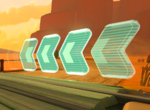 Arrow field |
Tour Paris Promenade Tour Tokyo Blur Tour New York Minute N64 Kalimari Desert Tour Sydney Sprint Tour London Loop Tour Berlin Byways DS Peach Gardens Tour Amsterdam Drift Tour Bangkok Rush Tour Singapore Speedway Tour Athens Dash Tour Los Angeles Laps Tour Vancouver Velocity Tour Rome Avanti Piranha Plant Cove Tour Madrid Drive |
Large, holographic, floating arrows that point in the direction that the players should go and change position each lap (or only in the last lap in Tour Paris Promenade and DS Peach Gardens), altering the path of the course. If the player goes past them, they will be considered out of bounds and taken back onto the track by Lakitu. In multiplayer, the arrow fields are independent to each player, meaning that if multiple players are on different laps, the arrow fields will be different for each of them to match what lap they are on. Arrow fields are red in most of the city courses and DS Peach Gardens and are teal in N64 Kalimari Desert and Tour Bangkok Rush, though this is simply a visual difference. |
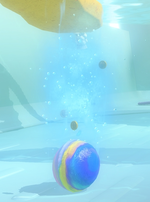 Bath Bomb |
Squeaky Clean Sprint | Large, opal colored bath bombs that fizz underwater. Players can trick whilst inside the bubbles produced, similarly to a geyser. |
 Bob-omb Car |
Wii Moonview Highway | Bob-omb-based vehicles that explode upon contact. If a player drives into one, they spin out in the same way as if they were caught in the blast of a regular Bob-omb. |
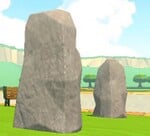 Boulder |
Tour Sydney Sprint | Objects scattered around grassy portions of the course. They slow down drivers on contact. |
 Bumper |
DS Waluigi Pinball | Obstacles that bounce players and metal balls that touch them away from themselves. Some are stationary, while others move in circles. |
 Ceiling Needles |
Ninja Hideaway | Giant shuriken stuck to broad ceilings that slowly rise and fall at set intervals, serving as obstacles for players on the course's lower route, while the ceilings themselves serve as platforms for players on the upper route, with a ramp on one of them. |
 Clampy |
GCN Daisy Cruiser Piranha Plant Cove |
Clampys open and shut periodically. They contain Item Boxes. |
 Exploring Shy Guy |
GBA Sunset Wilds | Exploring Shy Guys skip back and forth across the track. If a player makes contact with one, the player spins out. If they hit one with an item, they will drop 3 coins. |
 Fire Piranha Plant |
DS Mario Circuit | Piranha Plant variants that shoot fireballs that bounce across the course, causing racers to spin out. |
 Flipper |
DS Waluigi Pinball | Large obstacles that can swing back and forth and push back metal balls that collide with them. Players who collide with them are knocked over. |
 Fuzzy |
Tour Rome Avanti | Black furry creatures on circular tracks. They circle around coins, and spin players out when collided with. |
 Goal Ring |
Yoshi's Island | A decorative item that appears near the finish line. |
 Goonie |
Yoshi's Island | Spectators who appear in the background during the volcano ascent. |
 Half-pipe |
Wii Maple Treeway Merry Mountain Wii DK Summit GCN Waluigi Stadium Tour Athens Dash Squeaky Clean Sprint Tour Los Angeles Laps Wii Koopa Cape GCN DK Mountain 3DS Rosalina's Ice World Wii Rainbow Road |
Vertical ramps that allow players to jump off the side of a course and perform a Jump Boost to gain a speed boost upon landing. They resemble Antigravity Panels and briefly put the player into anti-gravity mode while they are airborne. |
 Huffin Puffin |
Yoshi's Island | Enemies who wander around near the starting line, occasionally onto the track. Players who collide with them will stop but not spin out. |
 Icicle |
3DS Rosalina's Ice World | Upward-pointing icicles on the ground that break when driven into, but will also slow the driver down. |
 Innertube Goomba |
Tour Singapore Speedway GCN Daisy Cruiser |
Innertube Goombas float above water. If made contact with, the player spins out. |
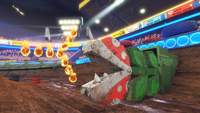 Mecha Piranha Plant |
GCN Waluigi Stadium | Large retracting obstacles that act like moving walls and stop any players who run into them. |
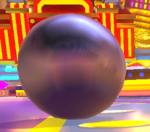 Metal ball |
DS Waluigi Pinball | Giant spherical obstacles that roll throughout the course and knock over players they collide with. In the pinball table section at the end of the course, they are bounced around in different directions by bumpers and flippers. |
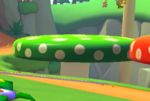 Mushroom Platform |
Wii Mushroom Gorge | Large, green mushrooms with white spots. Though shaped identically to Mushroom Trampolines, they are functionally different in that they act like regular surfaces rather than bouncing players into the air. A Jump Boost can be performed when driving off the edge of a Mushroom Platform. |
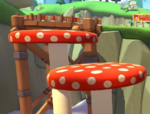  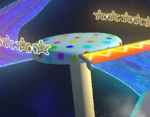 Mushroom Trampoline |
GBA Sky Garden Wii Mushroom Gorge 3DS Rainbow Road Squeaky Clean Sprint |
Large mushrooms that bounce the player into the air, allowing them to perform a Jump Boost. They are red with white spots in GBA Sky Garden and Wii Mushroom Gorge and are white with multi-colored spots in 3DS Rainbow Road. Wii Mushroom Gorge also contains one Mushroom Trampoline that is blue with white spots and functions differently to the others: it bounces the player upwards and activates their glider on contact, also giving them an opportunity to perform a Jump Boost. In GBA Sky Garden, there are also leaves that have the same properties of bouncing the player into the air as regular Mushroom Trampolines. |
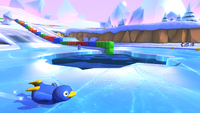 Penguin |
GBA Snow Land 3DS Rosalina's Ice World |
Enemies that either waddle or slide on their bellies around the course. Players who collide with them spin out. |
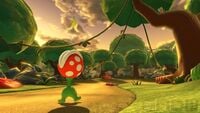 Ptooie |
GBA Riverside Park | Enemies that walk around the course. They are shown to be carrying Mushrooms and Bananas which they will drop if bumped into them or hit with another item. |
 Rocky Wrench |
Tour Rome Avanti | Mole-like creatures who hide in manholes. They occasionally pop up out of the ground, stopping players who drive into them. When underground, racers can drive over them with no consequences. If they're half above the ground, they can be tricked off. |
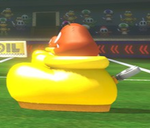 Shoe Goomba |
Tour Madrid Drive | Big Goombas wearing bright yellow Shoes. They kick Soccer Balls around. |
 Shy Guy (Ninja) |
Ninja Hideaway | Shy Guys clad in ninja outfits. They stand in place and act as hazards, causing players who collide with them to spin out. They will also occasionally transform into a Banana. There are also Shy Guys that fly with kites during the glider section and touching one will cause the player to lose their glider, making them fall. |
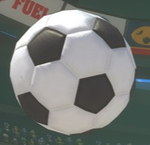 Soccer Ball |
Tour Madrid Drive | Big balls kicked around by Shoe Goombas. They bounce on the floor, spinning out racers who they collide with. |
 Stilt Guy |
Yoshi's Island | Enemies that slowly move back and forth across the track at the beginning of the course. Touching them causes the player to spin out. |
 Snowboarding Shy Guy |
Wii DK Summit | Shy Guys that snowboard across the snow and perform tricks on half-pipes. Driving into them will cause the player to spin out. |
 Table |
GCN Daisy Cruiser | Tables, decorated with cloths, candles, and plates. They rock side-to-side, and act as a wall for players. Spectators may be seated at these tables. |
 Train |
N64 Kalimari Desert | A moderately fast train which follows a set railway. Hitting it on impact results in the player being knocked over. |
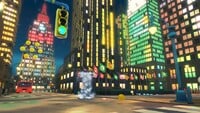 Water Geyser |
Tour New York Minute Tour Singapore Speedway Yoshi's Island Squeaky Clean Sprint Piranha Plant Cove Tour Madrid Drive |
Geysers that occasionally burst out from the ground for a few seconds before disappearing. Coming into contact with one boosts the player upwards, at which point they can perform a Jump Boost. In Tour New York Minute, they emerge under manhole covers, which function as platforms. |
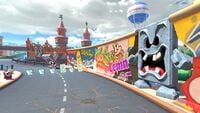 Whomp |
Tour Berlin Byways | Enemies that stand in gaps in the Berlin Wall. They slam their faces onto the track and flatten any players caught under them, but their edges can then be used to perform Jump Boosts before they get back up. |
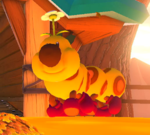 Wiggler |
Wii Maple Treeway DS Mario Circuit Tour Madrid Drive |
Enemies that walk around at a slow speed with occasional stops. Driving into them results in the player spinning out. Sometimes they can be seen sleeping. |
 Winged Cloud |
Yoshi's Island | An item that appears during the second glider section. When touched, it bursts and causes a red bridge shortcut to appear. |
New items
The Boo item makes a return in this game, functioning as it had previously. The Feather was added to Battle mode only, and is impossible to obtain otherwise. All other items from the Wii U version return as well, with their item distributions altered.
Coins | |
|---|---|
 Cash |
The equivalent of a coin, used for Urchin Underpass. They replace coins both as an item and on the track. |
 Coin (Yoshi's Island) |
In the Yoshi's Island course, coins have an altered appearance that resembles their design in the Yoshi's Island series, both as an item and on the track. |
New items | |
 Boo |
Allows the player to become invisible to other racers for 10 seconds. While invisible, players will also be granted immunity to items and obstacles. Activating the item will also allow Boo to steal an item from a randomly selected racer in front of the player. If there are no items to steal, Boo will bring back a single Mushroom by default. If Boo steals a multiple usage item or a timed item, it will be returned to the player fresh. Boo cannot steal Crazy 8s or Piranha Plants and Bullet Bills already in use. Only one Boo can be in play at a time; once it brings back an item, another can appear in Item Boxes again, even while a player is still invisible. Players who are under the effect of a Super Star or a Boo are not immune to Boo's item stealing. |
 Feather |
Causes the player to spin and leap in the air, providing a small speed boost upon landing, akin to a regular trick (characters will also perform a trick animation during the jump). When used near an opponent, the player steals a balloon, 3 coins, or the Shine Sprite from them, depending on the mode; however, the player needs to touch the opponent to steal from them, either by touching them upon use, or upon landing. Can be used on trickable places to gain more height, though does not grant more height if used while airborne, and cancels the gliding immediately. Exclusive to Battle mode. |
New amiibo compatibility
In addition to all of the compatible amiibo in Mario Kart 8 and their respective Mii racing suits, Mario Kart 8 Deluxe adds compatibility with amiibo from the Splatoon line, which unlock a Mii racing suit based on Splatoon. Additionally, more amiibo can be used to unlock the returning Mii racing suits, with all Animal Crossing-related amiibo unlocking the Animal Crossing Suit and the Pikmin amiibo unlocking the Pikmin Suit. Version 3.0.0 adds compatibility with the Daisy amiibo to unlock the Daisy Mii racing suit, as well as any amiibo from the Legend of Zelda, Metroid, and Kirby series to unlock their respective suits.
Update history
- Main article: Mario Kart 8 Deluxe update history
Mario Kart 8 Deluxe has received many updates since launch. Most of them addressed technical aspects of the game, while others expanded controller support (e.g. Toy-Con Motorbike and Toy-Con Car) or delivered new content, such as a variant of Link wearing his Champion's Tunic from The Legend of Zelda: Breath of the Wild, support for the Mario Kart 8 Deluxe – Booster Course Pass DLC, a Custom Items setting, and a menu for listening to the music of each of the game's courses. In order to play online, players must have downloaded the most recent software update.[19]
Official tournaments
- For official competitions held in the game's Wii U version, see Mario Kart 8 § Official competitions.
Nintendo has sponsored many Mario Kart 8 Deluxe tournaments, held either online or at special events, with prizes ranging from virtual My Nintendo points to physical merchandise and memorabilia. Nintendo's online tournaments are restricted to one country or region, and may be recurrent on a weekly, monthly, or seasonal basis as part of a named series.
The following is a list of Mario Kart 8 Deluxe competitions held or sanctioned by Nintendo.
Worldwide
| Title | Location | Banner |
|---|---|---|
| My Nintendo Mario Kart 8 Deluxe Community Challenge | Online | 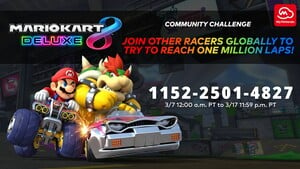
|
North America
| Title | Location | Banner |
|---|---|---|
| NOA 150cc Tournament NOA Battlethon |
Online | N/A |
| Mario Kart North American Open | Online | 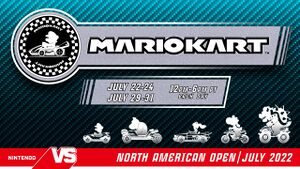
|
| Mario Kart 8 Deluxe Holiday Fun Run | Online | 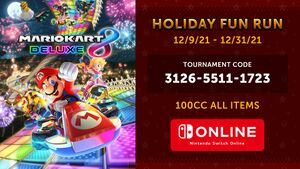
|
| Mario Kart 8 Deluxe Championship Cup 2022 | Seattle Convention Center (PAX West 2022) |
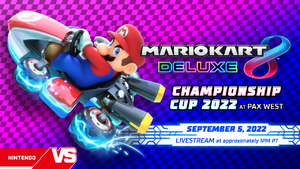
|
| Mario Kart 8 Deluxe North American Qualifier 2022 | Online | 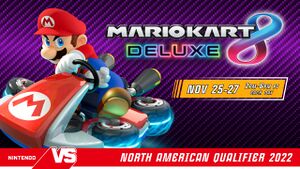
|
| Mario Kart 8 Deluxe North American Qualifier 2023 | Boston Convention and Exhibition Center (PAX East 2023) |
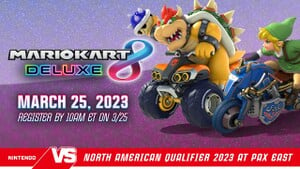
|
| Mario Kart 8 Deluxe Championship Cup 2023 | Boston Convention and Exhibition Center (PAX East 2023) |
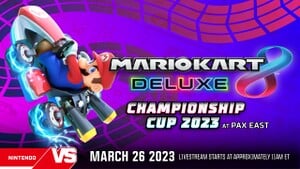
|
| Mario Kart 8 Deluxe Championship 2023 Qualifier | Online | 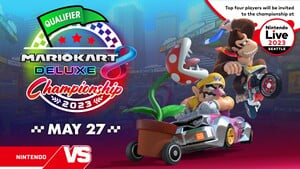
|
| Mario Kart 8 Deluxe Championship 2023 Qualifier at Nintendo Live | Seattle Convention Center (Nintendo Live 2023) |
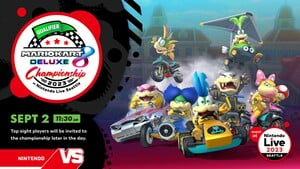
|
| Mario Kart 8 Deluxe Championship 2023 | Seattle Convention Center (Nintendo Live 2023) |
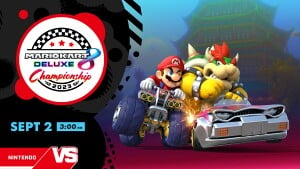
|
Australia and New Zealand
| Title | Location | Banner/logo |
|---|---|---|
| 2017 tournaments | Online | N/A |
| Mario Kart 8 Deluxe Super Saturdays | Online | N/A |
| Mario Kart AU/NZ My Nintendo Cup | Online | 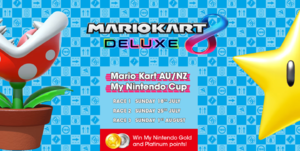
|
| Mario Kart 8 Deluxe: AU/NZ Grand Prix | Online | 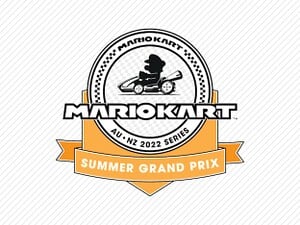
|
China
| Title | Location | Banner |
|---|---|---|
| Mario Kart 8 Deluxe Summit Invitational Tournament | Online | 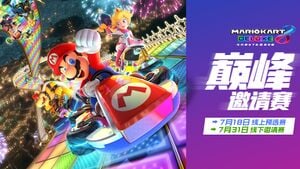
|
| Mario Kart 8 Deluxe Online Tournaments | Online | 
|
| Mario Kart 8 Deluxe National Battle Team Open Tournament | Online | N/A |
| Mario Kart 8 Deluxe Open Team Championship | Shanghai (exact location TBD) | N/A |
Europe
| Title | Location | Banner/logo |
|---|---|---|
| Mario Kart 8 Deluxe Seasonal Circuit | Mostly online. The sole exception is the gran final of the 2022 Mario Kart 8 Deluxe Seasonal Circuit Spain event, which took place at the Gamergy event in Madrid. | 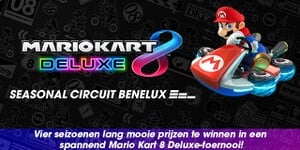
|
| Mario Kart 8 Deluxe European Championship 2023 | The qualifiers were held online. The final rounds were held at the VILCO convention center in Bad Vilbel, Germany. | 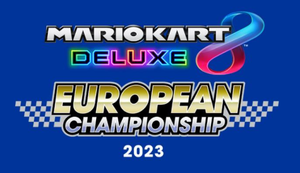
|
Hong Kong
| Title | Location | Banner |
|---|---|---|
| Nintendo HK 2021 Cup | Online | 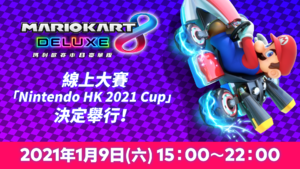
|
Japan
| Title | Location | Logo |
|---|---|---|
| Mario Kart 8 Deluxe Online Challenge | Online | 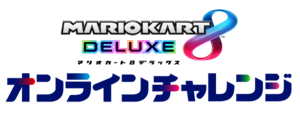
|
| Mario Kart 8 Deluxe Online Challenge Final Stage | Tokyo International Exhibition Center (Nintendo Live 2022) |
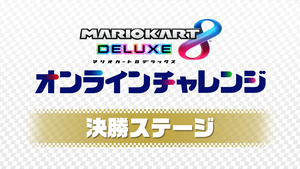
|
| Mario Kart 8 Deluxe World Championship 2024 | TBD | 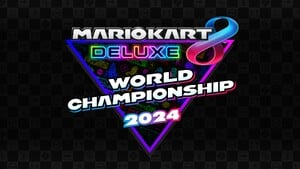
|
Spain
| Title | Location | Banner |
|---|---|---|
| #TorneoMK8D | Online | 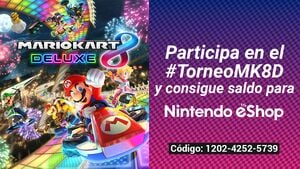
|
United Kingdom and Ireland
| Title | Location | Banner |
|---|---|---|
| Mario Kart 8 Deluxe Insomnia63 Grand Prix[20] | National Exhibition Centre, Birmingham (Insomnia63) |
N/A |
| Nintendo UK VS Cup | Online | N/A |
| Nintendo VS UK Cup | Online | N/A |
Staff
- Main article: List of Mario Kart 8 Deluxe staff
Pre-release and unused content
Early Booster Course Pass course designs
Some of the courses in the Mario Kart 8 Deluxe – Booster Course Pass had several differences between promotional material and their final release, some of which made the courses further resemble their Mario Kart Tour counterparts:
- Prior to Wave 1's launch, Tour Paris Promenade had simpler detailing overall, most notably in the lighting, trees, and the road. At the left turn that leads to the Luxor Obelisk at the end of the track, the right path, which is used in the final lap, was blocked by fences, some of which have arrows, rather than the backside of a metal ramp like in the final version. The optional glide ramp featured in the final lap was also not present, and consequently neither was the coin on top of the parasol. The ramp in front of the Eiffel Tower, though still functioning like a glide ramp, had the appearance of a normal ramp, similar to Paris Promenade 3. Likewise, the dash panel underneath the Eiffel Tower appears to have been invisible, as while seemingly not present, drivers are still seen driving towards it in multiple clips. The Piranha Plant cutouts blocking the shortcut through the Arc de Triomphe were not present. There was an arrow on the Eiffel Tower pointing towards the path from Paris Promenade 3 not present in the final version.
- Prior to Wave 1's launch, the sand in 3DS Toad Circuit was a very dark yellow color, as opposed to the bright sand-like color in the final version. The starting banner was significantly different, with the objects at the top corners being smaller, less round and generally less detailed, the bolts not being present and the horizontal shafts being missing from the columns. There was no confetti present around the starting line, despite confetti still falling there. The checkered line on the road continued onto where the starting grid is, instead of ending before it. There were significantly fewer flowers and plants present around the course. The coins present on the course differ in multiple ways, such as there being a row of them shortly after the starting line, an extra coin present at the final turn, there not being a coin on the ramp shortcut and coins having different positions in general. The final row of Item Boxes did not feature a Double Item Box.
- Prior to Wave 1's launch, N64 Choco Mountain had a significantly different road texture, while the walls and rocks lacked the detail they have in the final version. The cracks on the road around where the rocks fall were completely absent, and the coins present after where the second rock falls were instead after the first rock. There appear to have originally been coins leading up to the cave, while conversely the coins on the final turn appear to have been missing. Some of the lights within the cave emitted light onto the ceiling similarly to the crystals, unlike in the final version. The glide ramp leading out of the cave was invisible. Certain wooden elements like fences and the boards at the end of the gliding section had different coloring.
- Prior to Wave 1's launch, Wii Coconut Mall's exterior was a bright, pale peachy color, but in the time between its reveal and release, it was updated to be a more vibrant orange. This also applied to certain parts of the interior. Likewise, the stone floor in the center of the mall was originally gray, while it was changed to orange in the final version. The reflections on the windows had also been changed during this time. The flower bushes present around the mall's exterior were a lot less detailed and had a mix of white and purple flowers instead of the yellow ones the final version uses. The Mario Kart TV vans were not present. There was no row of Item Boxes at the entrance to the courtyard. The escalator rails were significantly less glossy, and all escalators seem to have had coins at the bottom of them. Similarly, both dash panels in the courtyard had a coin following them. The coins on the turn following the gliding section were instead on the road leading to it. Oddly, the results screen following a Grand Prix or a VS match uses an image of the old design despite the existence of an updated version of said image.
- Prior to Wave 1's launch, the Kaminarimon's lantern in Tour Tokyo Blur looked less saturated and lacked the ridges it has in the final version. The sun was not present over Mount Fuji, and the different lighting made the clock on the Wako store appear significantly brighter. The bushes were less detailed, having a less rough texture and much simpler flowers. The platform which the flower bushes leading to the Kaminarimon are on did not have its outer layer raised. The cracks on the road that appear underneath the Thwomps were completely absent. The text on the "Welcome to Tokyo" sign was significantly dimmer. The roadside barriers with arrows had much simpler designs, with the arrows being 2D instead of fully modeled like they are in the final version. There is also footage of this course showing an early design for the arrow field, in which the arrows have an identical design to the green arrow holograms in SNES Rainbow Road.[21]
- Prior to Wave 1's launch, DS Shroom Ridge did not have the glide ramp shortcut on the grass patch. The wind shortcut was also not present in trailer footage despite appearing in a released screenshot. Flowers, bushes and other plants had different, less detailed designs and appeared in different locations. Some notable examples include how the grass patch with the glide ramp featured alternating groups of blue and orange flowers instead of the multicolored ones present in the final version, and how the flower bushes were significantly less detailed and had red flowers and in smaller quantities compared to the pink flowers the final version has (oddly, future waves would exclusively use these lesser detailed flower bushes). The dividing stripes on the road continued through the starting grid instead of ending before it. The starting banner lacked details it has in the final version, such as the bolts on the columns, the lights across the top and most of the metal strips holding up the logo. The static coins at the turn adjacent to the wind shortcut appear to have initially been on the opposite side of the road.
- Prior to Wave 1's launch, GBA Sky Garden's textures for the road and the vine bridges were significantly larger. The final row of Item Boxes was slightly further into the course, and the Double Item Box was on the opposite side of the road. There was one more Mushroom Trampoline present underneath the course compared to the final version. The glide ramp at the end of the course was invisible. There were far less grass blades around the course. The flowers were blue with a much simpler design, while the flower bushes had less distinct and detailed shapes with multiple colors of flowers instead of just pink flowers like in the final version.
- Prior to Wave 2's launch, the first row of Item Boxes in Tour New York Minute was on the bridge leading into Central Park instead of being before it like in the final version. There were no Toads behind the front desk of 30 Rockefeller Plaza.
- Prior to Wave 2's launch, SNES Mario Circuit 3 had an additional coin in both the first turn and the turn with the first oil slick.
- Prior to Wave 2's launch, N64 Kalimari Desert had a floating group of coins that would have been reached by taking the first glide ramp shortcut. The second row of Item Boxes was shown as only having single Item Boxes in what appears to be the first lap, with the same clip showing Item Boxes present on the train tracks similarly to lap 3 of the final version. An arrow fence was present beside the road shortly after the second overlap between the road and the train tracks.
- Prior to Wave 2's launch, the helicopter in DS Waluigi Pinball was missing the beam of light eminating from its flashlight. The padels had the electricity effect at all times unlike the final version in which they only exhibit it upon activating.
- Prior to Wave 2's launch, GBA Snow Land had a row of Item Boxes after the starting line, in place of the moving Item Boxes present in the final version. The coins on the sheet of ice were in different positions. The row of Item Boxes on the ramp at the end of the sheet of ice were instead placed later on the following road with differing Double Item Box placements, and the ramp instead had a row of coins which are substituted by coins shortly after it in the final version. Some of the snow such as that present on the starting banner had significantly less detail. Some of the trees present on the course used simpler models.
- Prior to Wave 2's launch, Wii Mushroom Gorge had various differences in the placements of flowers throughout the course. The first row of Item Boxes was placed slightly earlier.
- Prior to Wave 2's launch, Sky-High Sundae did not have coins on the first two giant pieces of ice. The left split path had only three Item Boxes and they were placed earlier. The second coin on the path of ice-cream cones was placed slightly earlier.
- Prior to Wave 3's launch, the clock hands of Big Ben in Tour London Loop appeared perceptibly darker and less reflective in screenshots of the course. The row of coins in the area with the first Chain Chomp appears to have had at least one additional coin.
- When DS Peach Gardens was shown in the September 2022 Nintendo Direct, the loop at the beginning of the course lacked the barriers blocking off the right side, similar to previous iterations of the course, and even had at least one coin present. The arrow on the Mario topiary was also not present. The first flowerbed shortcut was much smaller. The route used to turn around on lap three was completely blocked off by a fountain, and the ramps at the mansion were also not present, though there was seemingly nothing else blocking that path. The Mario Kart TV van, spectators and benches were also not in that section at the time. The first row of Item Boxes was closer to the start of the bridge. The row of coins at the entrance to the maze was not present. In the Direct, the row of Item Boxes in the maze was replaced with a row of coins. However, in a screenshot released shortly after, there was a row of Item Boxes like in the final version, but with the addition of at least one more Double Item Box. There were no spectators after the starting line, nor on the windowsills close to it. The coins on the left of the mansion were gone in favor of a row of coins at the top of the stairs, and the coins around the Piranha Plant were gone in favor of there being coins in the following section with the Monty Moles.
- When Merry Mountain was shown in the September 2022 Nintendo Direct, there was one shot in which there were no Spin Boost Pillars on the mountain, with there instead only being a dash panel at the start of the descent. Screenshots would later show the mountain having both the dash panel and the Spin Boost Pillars, whereas the final version only has the latter. The suspended railroad had the ramp at the end angled more upwards than the rest of it, and was missing the wooden boards that are nailed onto it in the final version. The first row of Item Boxes was shown both not being present at all and being besides the grass shortcut, in which case taking the cut would not allow players to collect an item. The row of Item Boxes on the bridge were also not present. The Item Boxes at the top of the mountain were all lined up in a row, but with the Double Item Boxes still requiring drivers to take the half-pipe to collect them, and there was also a higher number of coins placed above the half-pipe. There was one less coin in the row before the split paths. There were no sitting spectators at the train station, nor besides the later part of the train track. The Toads on the mountain did not wear coats, and there were no spectators around the half-pipe. The snowman following the bridge was not present.
- When Yoshi's Island was shown in the February 2023 Nintendo Direct, Poochy was not present on the mailbox. The first row of Item Boxes was even closer to the bridge. Every arrow sign was double-sided, and the waterfalls had white outlines. There were less Yoshi spectators at in the first section of the course, but there was an additional Petal Guy next to where the second Stilt Guy is. The ramp leading into the underwater section had an additional coin, and the Yoshi spectator to the left of it was on the ground instead of on the tree root like it is in the final version. The underwater geysers had an effect at the bottom that resembled water splashing out of them, appeared less transparent and had fewer, smaller bubbles. The Yoshi spectator on the tower atop the clouds was not present, while the Paratroopas in this section were static instead of flying from side-to-side as in the final version. The animation for the pieces of the red bridge falling into place was simpler, with them already being in a horizontal position instead of flipping over like they do in the final version.
- When Squeaky Clean Sprint was shown in the June 2023 Nintendo Direct, there were no coins on top of the sink and the Yoshi's Egg soap dispenser. The nails on the wooden shelf had a darker color and were less reflective.
- When Wii Daisy Circuit was shown in the September 2023 Nintendo Direct, the objects to the left of the statue of Daisy and Luigi were arranged differently. The row of Item Boxes was in the opposite order, while the cones and coins were on the left half of the road. The cones and coins to the right of the statue of Baby Daisy and Baby Luigi were a little earlier. The glide ramp shortcut had only one Double Item Box. The two groups of coins around the lighthouse were both missing a coin. There were no coins in front of the Daisy Candy sign.
Original order of courses in Waves 3 to 6
In version 2.1.0 and onwards, the internal file names for some of the courses in the Booster Course Pass suggest that the release order in their respective cups differs from the originally planned order. Every course's internal file name has two digits, with the first indicating its intended wave and the second indicating its position in said wave (for example, Tour Berlin Byways' file name is "Cnsw_35", indicating that it is the fifth track in Wave 3, or the first track in the Moon Cup). In addition to several courses changing their order within their wave, several courses also switched waves entirely, such as GCN Waluigi Stadium, which was set to be in Wave 3's Moon Cup but was delayed to Wave 4 in favor of Wii Maple Treeway, whose internal file name suggests that it was once slated for Wave 6's Acorn Cup. Additionally, Wave 6 was originally intended to have 3 tracks without prefixes, but two of them were replaced by Wii Moonview Highway and 3DS Rosalina's Ice World, as indicated by their filenames. It was also originally intended to have a fourth GCN course, but this was replaced by Wii Daisy Circuit, as indicated by its filename.
Further evidence appears in an advertisement for Wave 3 posted by Nintendo of America on YouTube, which displays the courses in their original order, albeit with Wii Maple Treeway in place of GCN Waluigi Stadium; this advertisement was unlisted soon after its release.[22]
|
|
|
|
a - Although this slot originally lacked a prefix, Wii Moonview Highway's internal name assigns it to this slot.
b - Although this slot originally had a "GCN" prefix assigned to it, Wii Daisy Circuit's internal name assigns it to this slot.
c - Although this slot originally lacked a prefix, 3DS Rosalina's Ice World's internal name assigns it to this slot.
Music prefetches
In the 2.1.0 update, several prefetch music tracks of unreleased race courses were added to the game's files. They all sound different from their arrangements in Mario Kart Tour and the final arrangements used in the Booster Course Pass.
Wave 3
| File info 0:01 |
| File info 0:02 |
| File info 0:02 |
| File info 0:02 |
| File info 0:02 |
| File info 0:02 |
| File info 0:02 |
| File info 0:02 |
| File info 0:02 |
Wave 4
| File info 0:02 |
| File info 0:02 |
| File info 0:02 |
| File info 0:02 |
| File info 0:02 |
Wave 5
| File info 0:02 |
| File info 0:02 |
| File info 0:02 |
Gallery
Reception
Critical reception
Mario Kart 8 Deluxe has been received with universal acclaim, garnering higher aggregate scores than the original Mario Kart 8. The game has been praised for being well-suited to the Switch's portability, the increased performance, and particularly the redesigned Battle mode, although several reviews noted Mario Kart 8 Deluxe would not be as appealing of a proposition to players who already own Mario Kart 8 and its downloadable content.
| Reviews | |||
|---|---|---|---|
| Release | Reviewer, Publication | Score | Comment |
| Nintendo Switch | Laurely Birba, Jeux Actu | 18/20 | While purists may accuse Mario Kart 8 of being a opportunistic rehash, Nintendo's goal was to give the Switch a racing game that is fun, polished, filled with content, and able to showcase the Switch's hybrid nature. These four objectives are mostly accomplished, and the game will have no problem seducing newcomers considering how well the formula has been mastered. |
| Nintendo Switch | Kallie Plagge, GameSpot | 9/10 | Even if you didn't really care about Battle Mode, the smallest changes in Mario Kart 8 Deluxe refine an already great racing game. But the huge overhaul to the original's afterthought of a Battle Mode is a chaotic, varied opportunity to play very differently than in Grand Prix mode and well worth reinvesting yourself in Mario Kart 8 on Switch. |
| Nintendo Switch | Matthew Sainsbury, Digitally Downloaded | 4.5/5 | Thanks to substantial DLC releases, Mario Kart 8 on the Wii U went from being a game with plenty of content, to one with an overload of it. Mario Kart 8 Deluxe on the Nintendo Switch has all of that, plus the return of the battle mode (which should never have left), and while it won't be a new game as such for the people who actually bought a Wii U (we're a special club), having this game on a portable console is reason enough to buy it all over again. |
| Aggregators | |||
| Compiler | Platform / Score | ||
| Metacritic | 92 | ||
| GameRankings | 92.39% | ||
Sales
In the United Kingdom, Mario Kart 8 Deluxe debuted at No. 1 on the sales chart, making it the first Nintendo game to be No. 1 in the UK since 2011's Pokémon Black and White, and the first Super Mario game to place such since Mario Kart Wii.[23]
The game sold 459,000 copies for its US launch day, making it the fastest-selling Mario Kart game in the US and meaning 45% of US Switch owners purchased the game.[24]
As of December 31, 2017, Mario Kart 8 Deluxe had sold 7.33 million units worldwide. As of March 31, 2018, it reached 9.22 million units, exceeding the original Mario Kart 8's 8.42 million and making it the second best-selling game on the Nintendo Switch behind Super Mario Odyssey.[25] As of December 31, 2018, Mario Kart 8 Deluxe had sold 15.02 million units worldwide, exceeding Super Mario Odyssey's sales and making it the best-selling game on the Nintendo Switch.[26] As of September 30, 2021, the game had sold 38.74 million units worldwide, surpassing Mario Kart Wii as the best-selling game in the series.[27] As of December 31, 2021, the game had sold 43.35 million units worldwide, making it the single best-selling game in the Super Mario franchise, surpassing Super Mario Bros. for the Nintendo Entertainment System.[28] As of September 30th, 2025, the game had sold 69.56 million units worldwide.[29]
Awards and acknowledgements
Mario Kart 8 Deluxe was nominated for the "Best Family Game" and "Best Multiplayer" awards at The Game Awards 2017.[30] However, it won neither, losing the former to Super Mario Odyssey and the latter to PlayerUnknown's Battlegrounds.[30]
References to other games
- Pauline's horn noise is based on the stage clear jingle from this game.
- The Feather item returns from this game, with the same function.
- Battle Course 1 reappears as a classic battle course.
- A billboard in the course background is modeled after the player select screen from this game.
- Mario Circuit 3 and Bowser Castle 3 are included among the courses in the Booster Course Pass.
- The end credits theme is arranged for the Booster Course Pass's end credits theme.
- Bowser Jr. being one of Baby Mario's rivals and Kamek's rival in this game is a reference to Baby Bowser being Baby Mario's arch-nemesis and Kamek being Baby Bowser's caretaker respectively.
- Yoshi's Island, a course appearing in the Booster Course Pass, is heavily based on Super Mario World 2: Yoshi's Island.
- Likewise, Kamek's horn noise sounds like his speaking sound effect in Super Mario World 2: Yoshi's Island.
- Similar to this game, all courses in Mario Kart 8 Deluxe are unlocked from the start.
- Choco Mountain and Kalimari Desert are included among the courses in the Booster Course Pass.
- Sky Garden, Snow Land, Boo Lake, Riverside Park, and Sunset Wilds are included among the courses in the Booster Course Pass.
- King Boo's horn noise uses the sound of the King Boo from this game being hit by a pepper.
- Luigi's Mansion reappears as a classic battle course.
- The Double Item Boxes and the two Battle sub-modes, Bob-omb Blast and Shine Thief, return.
- Waluigi Stadium, Daisy Cruiser, and DK Mountain are included among the courses in the Booster Course Pass.
- Artwork of Baby Mario and Yoshi is reused from the game in the Yoshi's Island course on the mural outside of Yoshi's House.
- An arrangement of Luigi's Mansion's music is used in GCN Luigi's Mansion.
- Shroom Ridge, Waluigi Pinball, Peach Gardens, and Mario Circuit are included among the courses in the Booster Course Pass.
- Coconut Mall, Mushroom Gorge, Maple Treeway, DK Summit, Koopa Cape, Moonview Highway, Daisy Circuit, and Rainbow Road are included among the courses in the Booster Course Pass.
- Boo's artwork from this game is reused for King Boo's character select icon, albeit with the addition of the latter's crown.
- The flowering bushes in the forested section of DS Mario Circuit are based on those found in World 4 of this game.
- Canada Hockey Place reappears in the Vancouver Velocity track, now referred to by its sponsored name Rogers Arena.
- The Koopa Clown kart returns from this game.
- Wuhu Town reappears as a classic battle course.
- Toad Circuit, Rock Rock Mountain, Rainbow Road, and Rosalina's Ice World are included among the courses in the Booster Course Pass. Lunar Colony has a moon section with low gravity just like Rainbow Road from this game.
- The crown mechanic in Battle mode is similar to the mechanic in this game's multi-player, where the player with the highest score from one stage will be wearing a crown in the next stage.
- Funky Kong's character select icon is reused from this game.
- The Koopa Clown's propellers in anti-gravity sections emerge from circular panels on the side of the vehicle, much like the Junior Clown Car's weapons. Also, the Koopalings' Koopa Clowns match the Clown Car colors they use in this game.
- A ring similar to the Binding Band appears inside the drain in Squeaky Clean Sprint.
- New York Minute, Tokyo Blur, Paris Promenade, London Loop, Vancouver Velocity, Los Angeles Laps, Merry Mountain, Berlin Byways, Ninja Hideaway, Sydney Sprint, Singapore Speedway, Amsterdam Drift, Bangkok Rush, Piranha Plant Cove, Athens Dash, Rome Avanti, and Madrid Drive are included among the courses in the Booster Course Pass.
- The designs of the courses in the Booster Course Pass are based on their designs from Mario Kart Tour.
- N64 Kalimari Desert's second and third laps are based on the variant Kalimari Desert 2 from this game.
- Birdo, Petey Piranha, Wiggler, Kamek, Diddy Kong, Pauline, and Peachette reuse their face icons from this game.
- All the Mii racing suits included in Wave 6 come from this game.
- Some of their unique trick animations are also reused.
References in other games
- Key art for the game appears when tapping on the Nintendo Switch collectible in Kingdom Builder.
- The third level of Mini-Turbos, Ultra Mini-Turbos, returns.
- The Koopa Clown retains its appearance from this game.
- King Boo reuses his face icon from this game.
- Sky-High Sundae, Yoshi's Island, and Squeaky Clean Sprint all reappear, though they are considered new courses in both games.
- SNES Battle Course 1's music arrangement is used in Balloon Battles.
Gallery
- For this subject's image gallery, see Gallery:Mario Kart 8 Deluxe.
Multimedia
- For the complete list of media files for this subject, see Multimedia:Mario Kart 8 Deluxe. For this subject's sound test, see Mario Kart 8 Deluxe sound test.
| File info |
| File info |
| File info |
| File info |
| File info |
| File info |
| File info |
| File info |
Names in other languages
| Language | Name | Meaning | Notes |
|---|---|---|---|
| Japanese | マリオカート8 デラックス[?] Mario Kāto 8 Derakkusu |
Mario Kart 8 Deluxe | |
| Chinese (simplified) | 马力欧卡丁车8 豪华版[?] Mǎlì'ōu Kǎdīngchē 8 Háohuábǎn |
Mario Kart 8 Deluxe Edition | |
| Chinese (traditional) | 瑪利歐賽車8 豪華版[?] Mǎlì'ōu Sàichē 8 Háohuábǎn |
Mario Racing 8 Deluxe Edition | |
| Korean | 마리오 카트 8 디럭스[?] Mario Kateu 8 Direokseu |
Mario Kart 8 Deluxe |
Notes
- As the Nintendo Switch is not region-locked like previous Nintendo consoles (excluding console and game units officially sold in mainland China), this is the first Super Mario game to be playable in the same build in all regions.
- In the music menu, in addition to the usual method of pressing
to cycle through the different song variants of a course, it is possible to select a specific one via the shoulder buttons, similarly to selecting the season of Animal Crossing. Depending on the number of song variants a course has, holding
selects the first variant,
selects the second variant,
selects the third variant,
selects the fourth variant, and both
and
selects the fifth variant.
- In a public Reddit comment made in May 2018, Nintendo of America randomly notified a user that they had privately sent them a download code for Mario Kart 8 Deluxe.[31]
References
- ^ 遊戲軟體一覽 | 任天堂(香港)有限公司網站. Nintendo of HK (Traditional Chinese). Retrieved November 6, 2024.
- ^ Mario Kart 8 Deluxe: Product Information. Nintendo of Singapore (English). Retrieved June 1, 2024. (Archived February 13, 2024, 08:15:37 UTC via Wayback Machine.)
- ^ Mario Kart™ 8 Deluxe para la consola Nintendo Switch. Nintendo.com (Latin American Spanish). Retrieved November 6, 2024.
- ^ 한국닌텐도 홈페이지. Nintendo of Korea (Korean). Archived September 20, 2017, 03:54:42 UTC from the original via Wayback Machine. Retrieved November 6, 2024.
- ^ 任天堂(香港)有限公司. Nintendo of Taiwan (Traditional Chinese). Retrieved November 6, 2024.
- ^ March 13, 2020. 《马力欧卡丁车8 豪华版》《超级马力欧 奥德赛》将于3月16日发售 - 腾讯Nintendo Switch官网. Tencent (Simplified Chinese). Retrieved November 6, 2024.
- ^ Nintendo (November 16, 2023). The complete edition with all 96 courses available. Mario Kart™ 8 Deluxe + Booster Course Pass, launching on 1 December 2023. | News & Updates | Nintendo. Nintendo. Retrieved April 19, 2025. (Archived May 29, 2024, 22:12:35 UTC via Wayback Machine.)
- ^ https://x.com/flamebeam0131/status/1813531960620568895
- ^ Mario Kart™ 8 Deluxe Bundle (Game + Booster Course Pass). nintendo.com (American English). Retrieved January 31, 2023. (Archived January 28, 2023, 06:38:50 UTC via Wayback Machine.)
- ^ Nintendo World Report TV (January 14, 2017). Mario Kart 8 Deluxe - Wario's Gold Mine - Nintendo Switch Off-Screen Footage. YouTube (English). Retrieved November 6, 2024.
- ^ GameXplain (April 21, 2017). Luigi Wins by Doing Absolutely Nothing - Mario Kart 8 Deluxe (03:50). YouTube (English). Retrieved November 6, 2024.
- ^ Screenshot of the starting boost in a four-player split-screen VS Race.
- ^ https://www.ign.com/wikis/mario-kart-8/Switch_Version_Changes
- ^ a b Nintendo (November 1, 2024). 『マリオカート8 デラックス コース追加パス』最後の第6弾は11月9日配信決定。新キャラクターや「ミュージック」機能なども追加。. Nintendo of Japan (Japanese). Retrieved November 6, 2024.
- ^ Nintendo of America (September 14, 2023). Mario Kart 8 Deluxe - Booster Course Pass Wave 6 - Nintendo Switch 9.14.2023. YouTube (American English). Retrieved November 6, 2024.
- ^ @NintendoAmerica (July 20, 2018). A new update to #MarioKart 8 Deluxe is available now for #NintendoSwitch! Race like a champion with the Master Cycle Zero and Champion’s Tunic Link from The Legend of #Zelda: Breath of the Wild! This update also includes the Ancient Tires and the Paraglider parts!. X (American English). Retrieved September 12, 2023.
- ^ MK8D Stat sheet (Updated for W6). Google Docs (English). Retrieved November 6, 2024.
- ^ @zachruff (May 22, 2022). So it turns out that there are 4 staff ghosts in the Tencent Chinese version of MK8D that are actually different to the global version. It seems that they really did not like the Mercedes car parts so any ghost that used them had to be redone.. X (English). Retrieved May 24, 2022.
- ^ How to Update Mario Kart 8 Deluxe. Nintendo of America (American English). Retrieved November 6, 2024.
- ^ "Monday 27th August – Mario Kart 8 Deluxe Insomnia63 Grand Prix—Think you’ve got what it takes to get on the podium in the Mario Kart 8 Deluxe Insomnia63 Grand Prix? Race in a 150cc single elimination tournament taking place across increasingly trickier tracks, with the top two racers advancing to the next stage each time!" – August 9, 2018. Go hands-on with Super Smash Bros. Ultimate at Insomnia63 later this month!. nintendo.com (British English). Retrieved February 10, 2025. (Archived January 24, 2025, 15:19:36 UTC via Wayback Machine.)
- ^ Nintendo (December 25, 2022). マリオカート8 デラックス コース追加パス TVCM3 (0:23). YouTube (Japanese). Retrieved November 6, 2024.
- ^ Nintendo of America (November 22, 2022). Mario Kart 8 Deluxe - Booster Course Pass DLC Wave 3 - Nintendo Switch. YouTube (American English). Retrieved November 6, 2024.
- ^ Dring, Christopher (April 30, 2017). Mario Kart 8 Deluxe is Nintendo's first UK No.1 since 2011. GameIndustryBiz (English). Retrieved November 6, 2024.
- ^ Brian (May 1, 2017). Mario Kart 8 Deluxe sells 459,000 copies in the US on launch day, fastest-selling Mario Kart game. Nintendo Everything (English). Retrieved November 6, 2024.
- ^ Nintendo. IR Information : Sales Data - Top Selling Title Sales Units. Nintendo of Japan (English). Archived May 7, 2018, 00:57:30 UTC from the original via Wayback Machine. Retrieved November 6, 2024.
- ^ GameXplain (February 1, 2019). Nintendo's Financial Report - 30 Million Switches Sold Worldwide, Doubled Software Sales, & More!. YouTube (English). Retrieved December 22, 2020.[dead link]
- ^ Nintendo (November 4, 2021). Top Selling Title Sales Units. Nintendo Japan (English). Archived November 8, 2021, 09:04:38 UTC from the original via Wayback Machine. Retrieved November 8, 2021.
- ^ Nintendo. Top Selling Title Sales Units. Nintendo Japan (English). Archived February 3, 2022, 07:34:54 UTC from the original via Wayback Machine. Retrieved February 3, 2022.
- ^ Nintendo (November 4, 2025) [1]. Top Selling Title Sales Units - Nintendo Switch Software. Retrieved November 4, 2025.
- ^ a b Awards - The Game Awards 2017. The Game Awards. Archived November 14, 2017, 20:23:45 UTC from the original via Wayback Machine. Retrieved November 6, 2024.
- ^ Nintendo_America (May 12, 2017). Reply to user "Readalie" in "/r/NintendoSwitch's Daily Question Thread (05/12/2017)". Reddit (/r/NintendoSwitch). Retrieved September 28, 2025. (Archived September 28, 2025, 19:45:24 UTC via archive.today.)
External links
- Official Japanese site
- Official North American site
- Official Canadian site
- Official Latin American site
- Official European site
- Official Oceanian site
- Official Korean site
- Official Chinese (Hong Kong) site
- Official Chinese (Taiwan) site
- Official Chinese (Mainland) site
